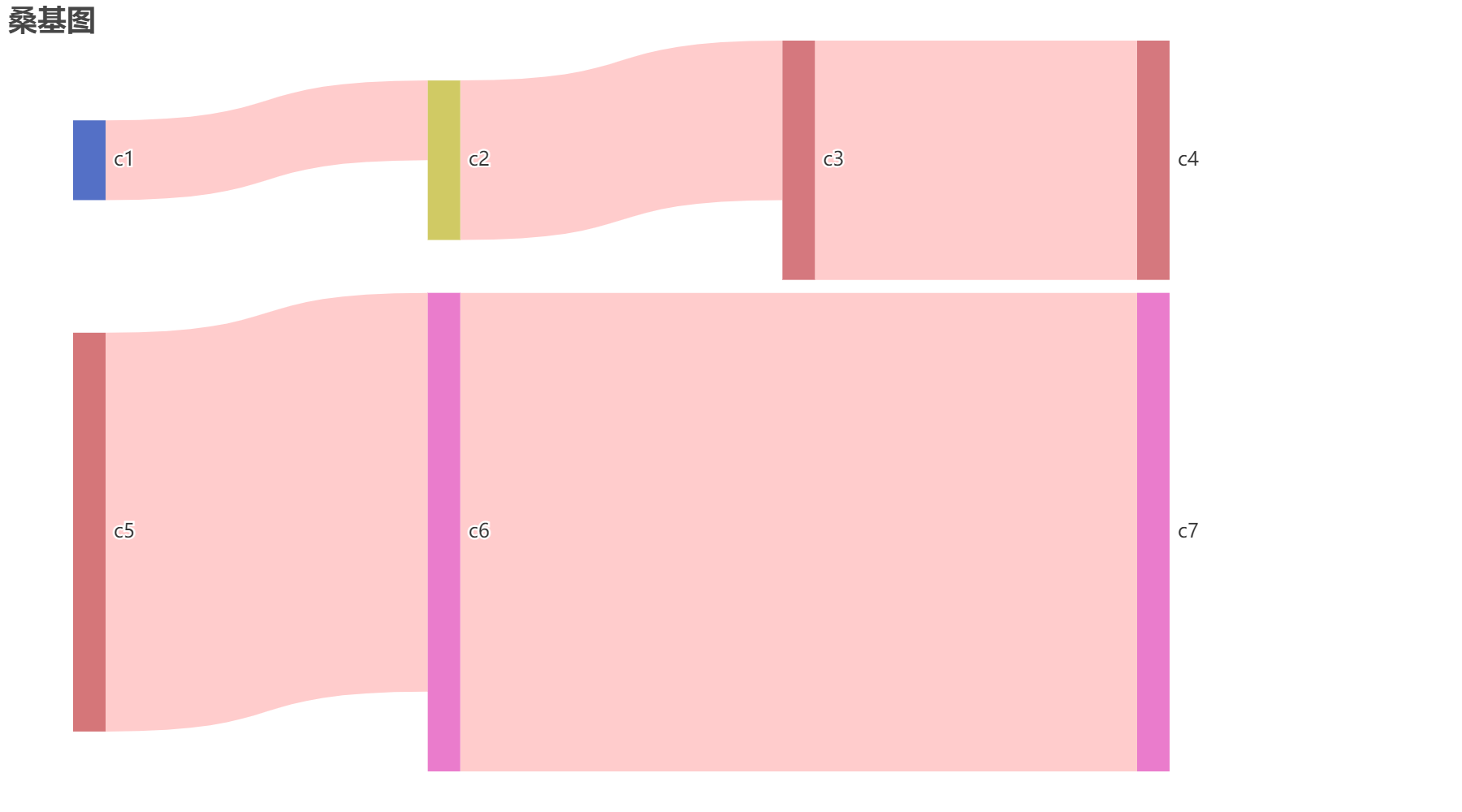pyecharts示例图
渲染图片文件方法
1
2
3
4
5
6
7
8
9
from pyecharts.render import make_snapshot
from snapshot_selenium import snapshot
bar = (
Bar()
.add_xaxis(["衬衫", "羊毛衫", "雪纺衫", "裤子", "高跟鞋", "袜子"])
.add_yaxis('商家',[5, 20, 36, 10, 75, 90])
)
make_snapshot(snapshot,bar.render(),'bar.png')
柱状图
1
2
from pyecharts.globals import CurrentConfig, NotebookType
CurrentConfig.NOTEBOOK_TYPE = NotebookType.JUPYTER_LAB
1
2
3
4
5
from pyecharts.charts import Bar
bar = Bar()
bar.add_xaxis(["衬衫", "羊毛衫", "雪纺衫", "裤子", "高跟鞋", "袜子"])
bar.add_yaxis('商家',[5, 20, 36, 10, 75, 90])
bar.load_javascript()
1
bar.render_notebook()
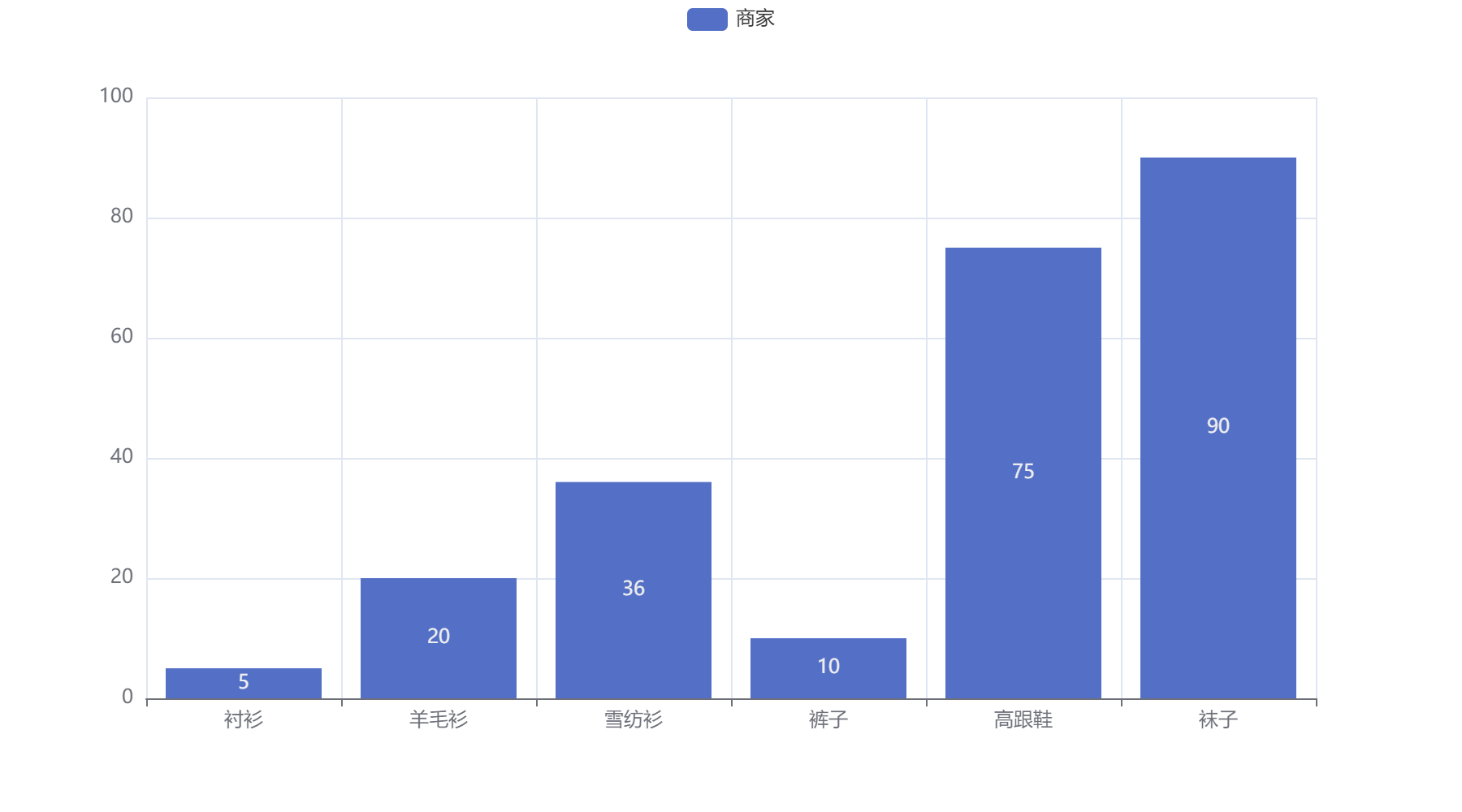
饼图
1
2
3
from pyecharts.charts import Pie
import pyecharts.options as opts
from pyecharts.faker import Faker
1
list(zip(Faker.choose(),Faker.values()))
1
2
3
4
5
6
7
[('河马', 139),
('蟒蛇', 41),
('老虎', 100),
('大象', 121),
('兔子', 80),
('熊猫', 47),
('狮子', 147)]
1
2
3
c = Pie()
c.add('',[list(x) for x in zip(Faker.choose(),Faker.values())])
c.render_notebook()
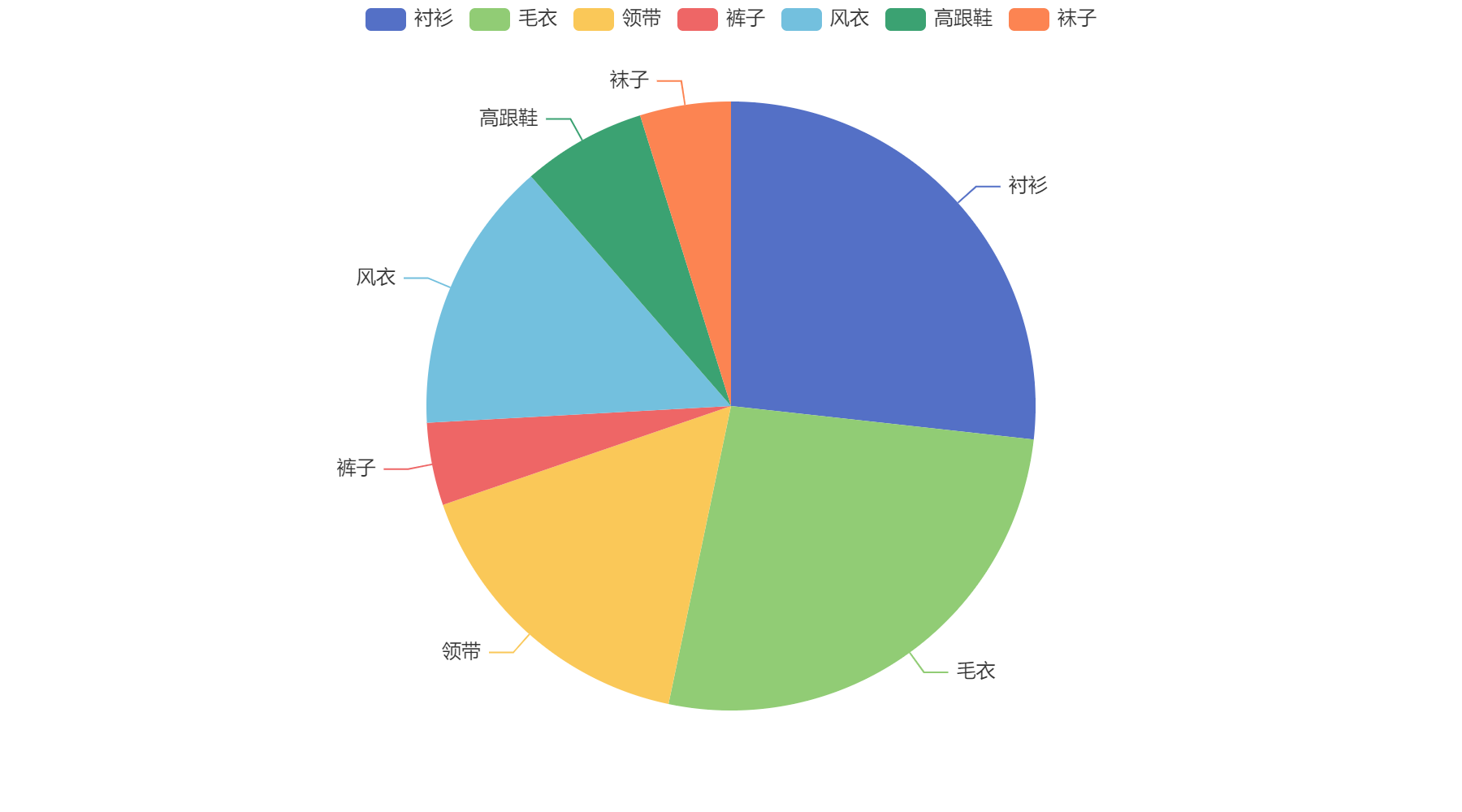
1
2
3
4
5
6
7
8
9
10
11
12
13
c = (
Pie()
.add('数量',[list(x) for x in zip(Faker.choose(),Faker.values())])
.set_colors(['#313695','#4575b4','#74add1','#abd9e9','#e0f3f8','#ffffbf','#fee090',])
.set_global_opts(
title_opts=opts.TitleOpts(title='设置颜色',pos_top=0,pos_left=0),
legend_opts=opts.LegendOpts(type_='scroll',pos_right=0,orient='vertical')
)
.set_series_opts(
label_opts=opts.LabelOpts(formatter="{b}:{c}"),
)
)
c.render_notebook()
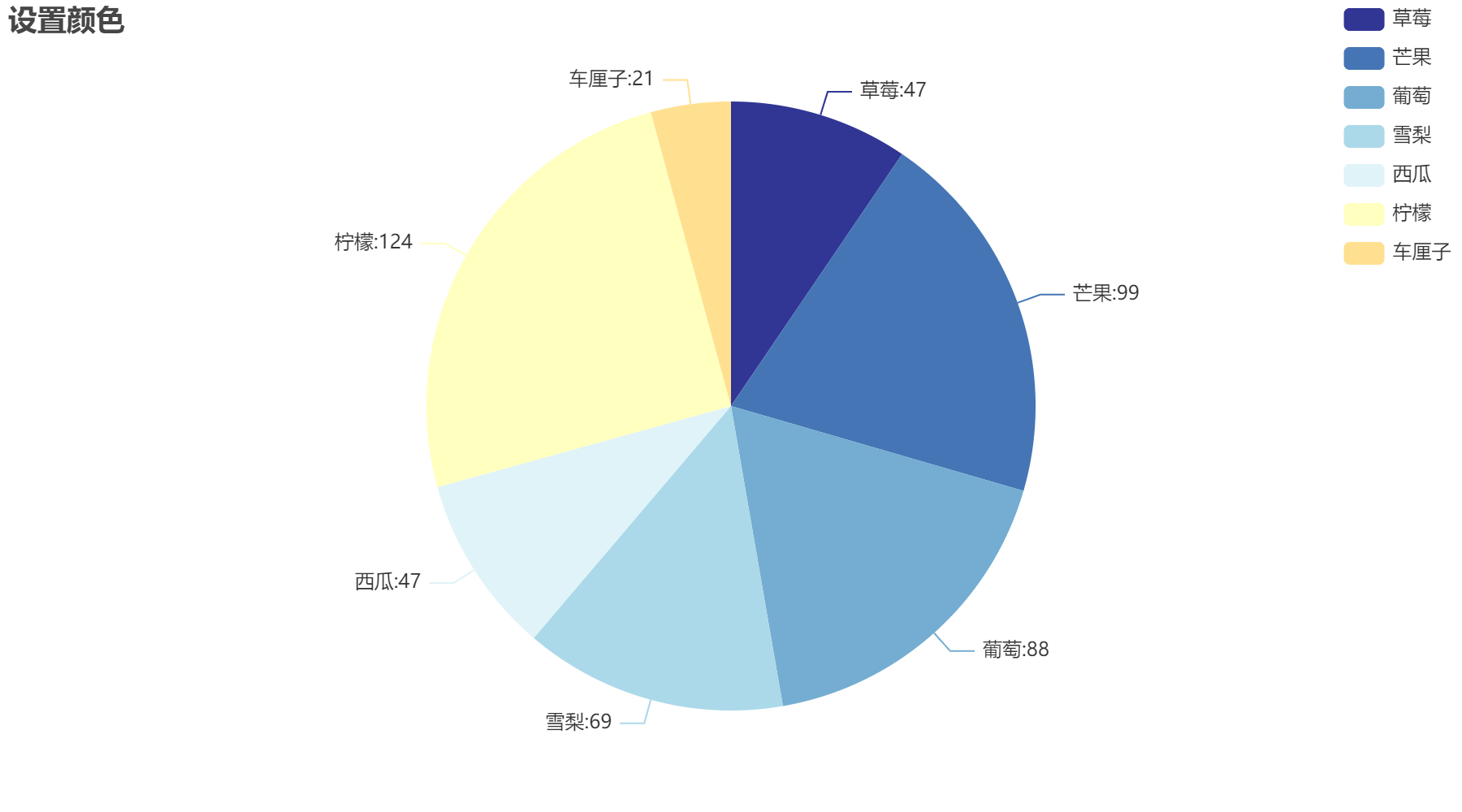
玫瑰图
1
2
v = Faker.choose()
v
1
['河马', '蟒蛇', '老虎', '大象', '兔子', '熊猫', '狮子']
1
2
3
4
5
6
7
8
9
10
11
12
13
14
15
16
17
18
19
20
21
c = (
Pie()
.add(
'',
[list(i) for i in zip(v,Faker.values())],
radius=['20%','70%'],
center=['20%','50%'],
rosetype='radius',
label_opts=opts.LabelOpts(is_show=False)
)
.add(
'',
[list(i) for i in zip(v,Faker.values())],
radius=['20%','70%'],
center=['80%','50%'],
rosetype='radius',
label_opts=opts.LabelOpts(is_show=True)
)
.set_global_opts(title_opts=opts.TitleOpts(title='南丁格尔玫瑰图'))
)
c.render_notebook()
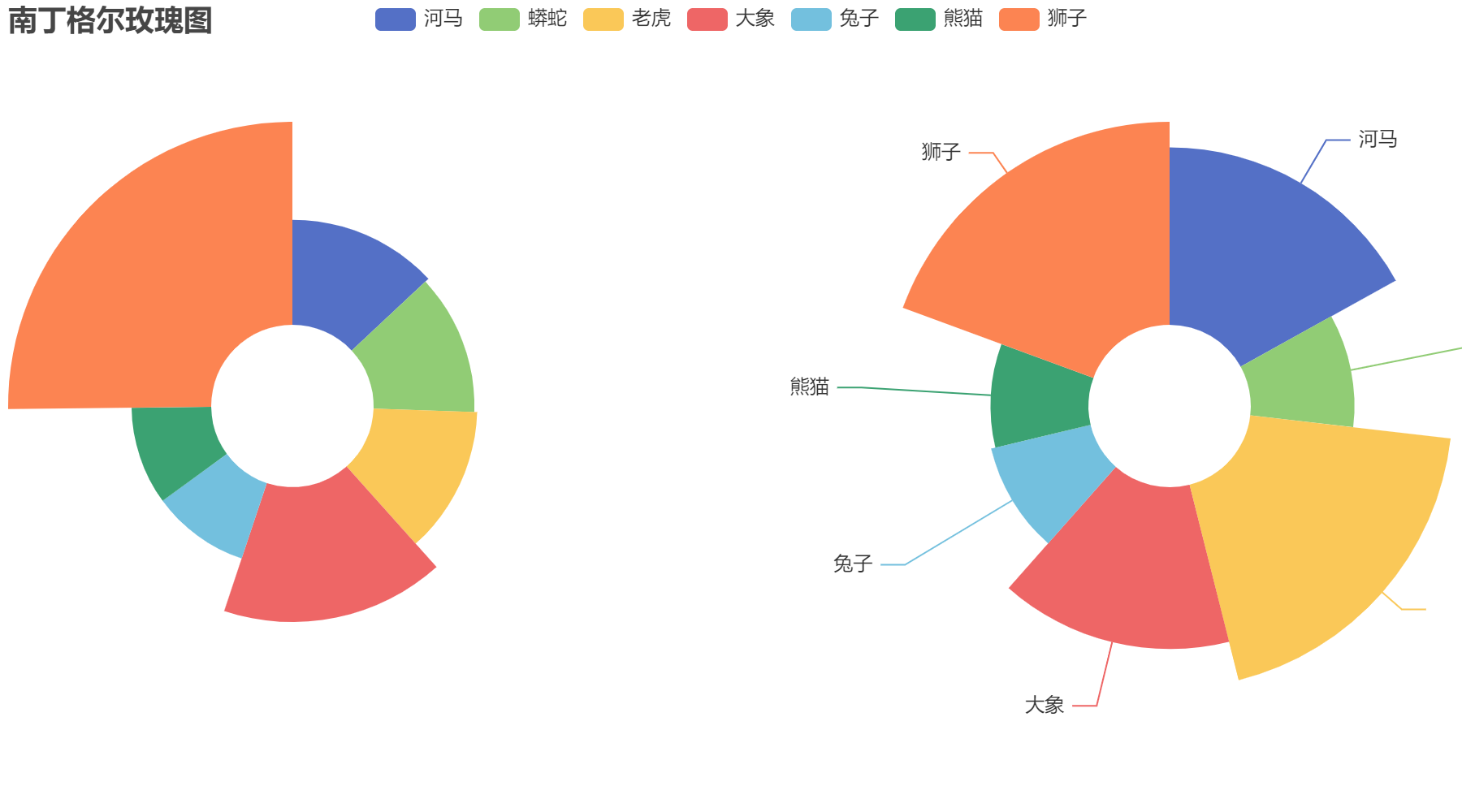
柱形图
1
from pyecharts.charts import Bar
1
2
3
4
5
6
7
8
9
10
c=(
Bar()
.add_xaxis(Faker.choose())
.add_yaxis('商家A',Faker.values())
.add_yaxis('商家B',Faker.values())
.set_global_opts(
title_opts=opts.TitleOpts(title='销量',subtitle='副标题')
)
)
c.render_notebook()
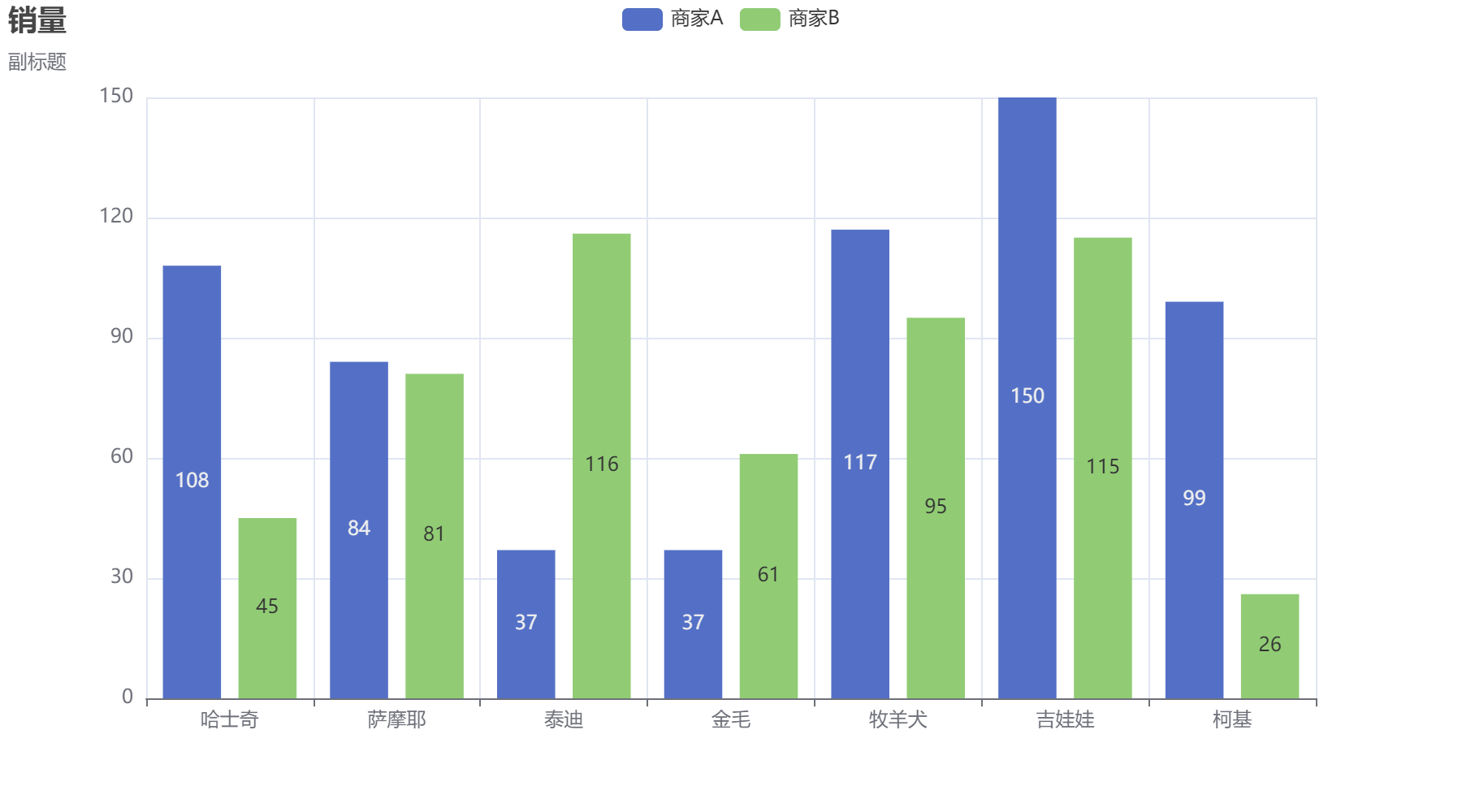
1
2
3
4
5
6
7
8
9
10
11
12
13
14
15
16
17
c=(
Bar(
init_opts=opts.InitOpts(
animation_opts=opts.AnimationOpts(
animation_delay=100, #延时动画1000ms
animation_easing='elasticOut' #弹性动画
)
)
)
.add_xaxis(Faker.choose())
.add_yaxis('商家A',Faker.values())
.add_yaxis('商家B',Faker.values())
.set_global_opts(
title_opts=opts.TitleOpts(title='销量',subtitle='副标题'),
)
)
c.render_notebook()
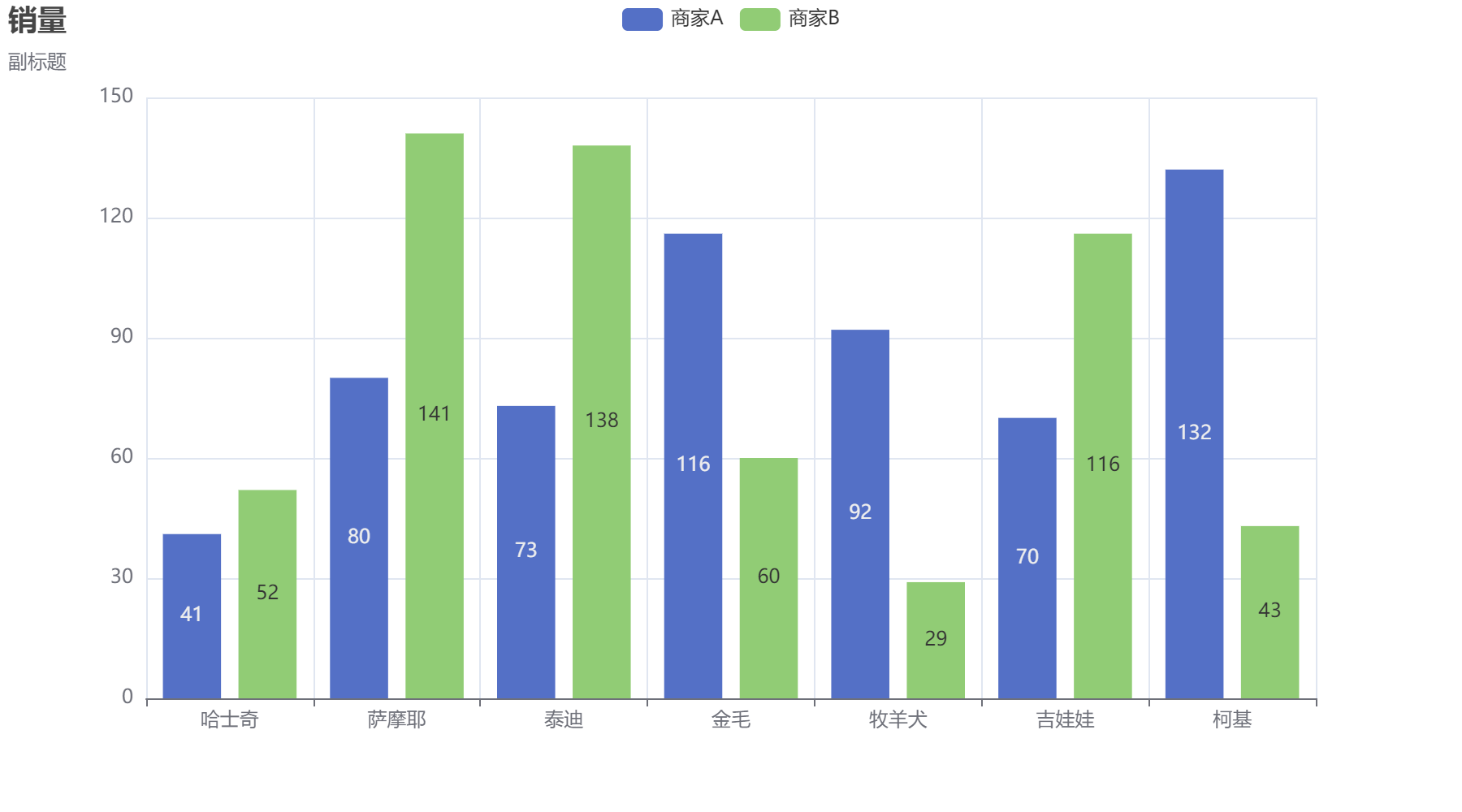
执行JS代码
1
from pyecharts.commons.utils import JsCode
1
2
3
4
5
6
7
8
9
10
11
12
13
14
15
16
17
18
19
20
21
22
23
24
c=(
Bar(
init_opts=opts.InitOpts(
bg_color={
'image' :JsCode('img'),
}
)
)
.add_xaxis(Faker.choose())
.add_yaxis('商家A',Faker.values())
.add_yaxis('商家B',Faker.values())
.set_global_opts(
title_opts=opts.TitleOpts(title='销量',subtitle='副标题'),
)
)
#添加js代码
c.add_js_funcs(
"""
var img = new Image();
img.src = "http://localhost:8888/files/pyecharts/%E3%81%82%E3%81%99%E3%81%8B.jpg?_xsrf=2%7C2b50c939%7Cd7ba3194aadfcc7497a9007df4693a2c%7C1722234893"
"""
)
c.render_notebook()
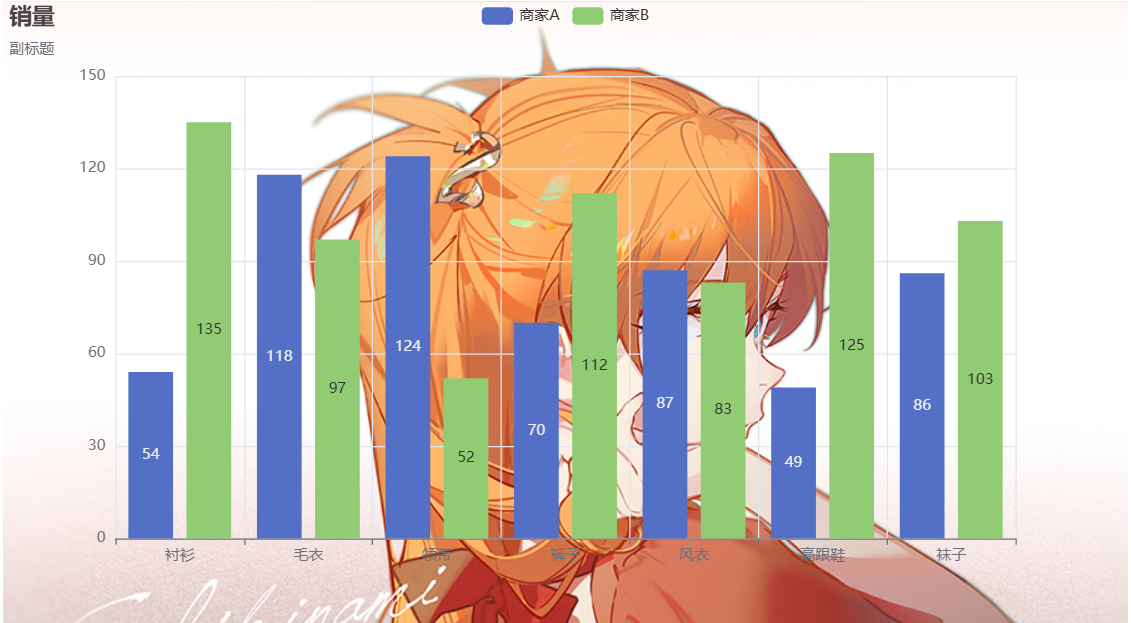
堆叠柱状图
1
2
3
4
5
6
7
8
9
10
11
12
13
14
15
16
17
18
19
20
21
22
23
c=(
Bar()
.add_xaxis(Faker.choose())
.add_yaxis('商家A',Faker.values(),stack='abc')
.add_yaxis('商家B',Faker.values(),stack='abc')
.set_series_opts(
label_opts=opts.LabelOpts(is_show=False)
)
.set_global_opts(
title_opts=opts.TitleOpts(title='堆叠柱状图',subtitle='副标题'),
xaxis_opts=opts.AxisOpts(
axislabel_opts=opts.LabelOpts(rotate=45)
),
#缩放
datazoom_opts=[
opts.DataZoomOpts(), #x轴拖拉缩放
opts.DataZoomOpts(type_='inside') #滚轮缩放
]
)
)
c.render_notebook()
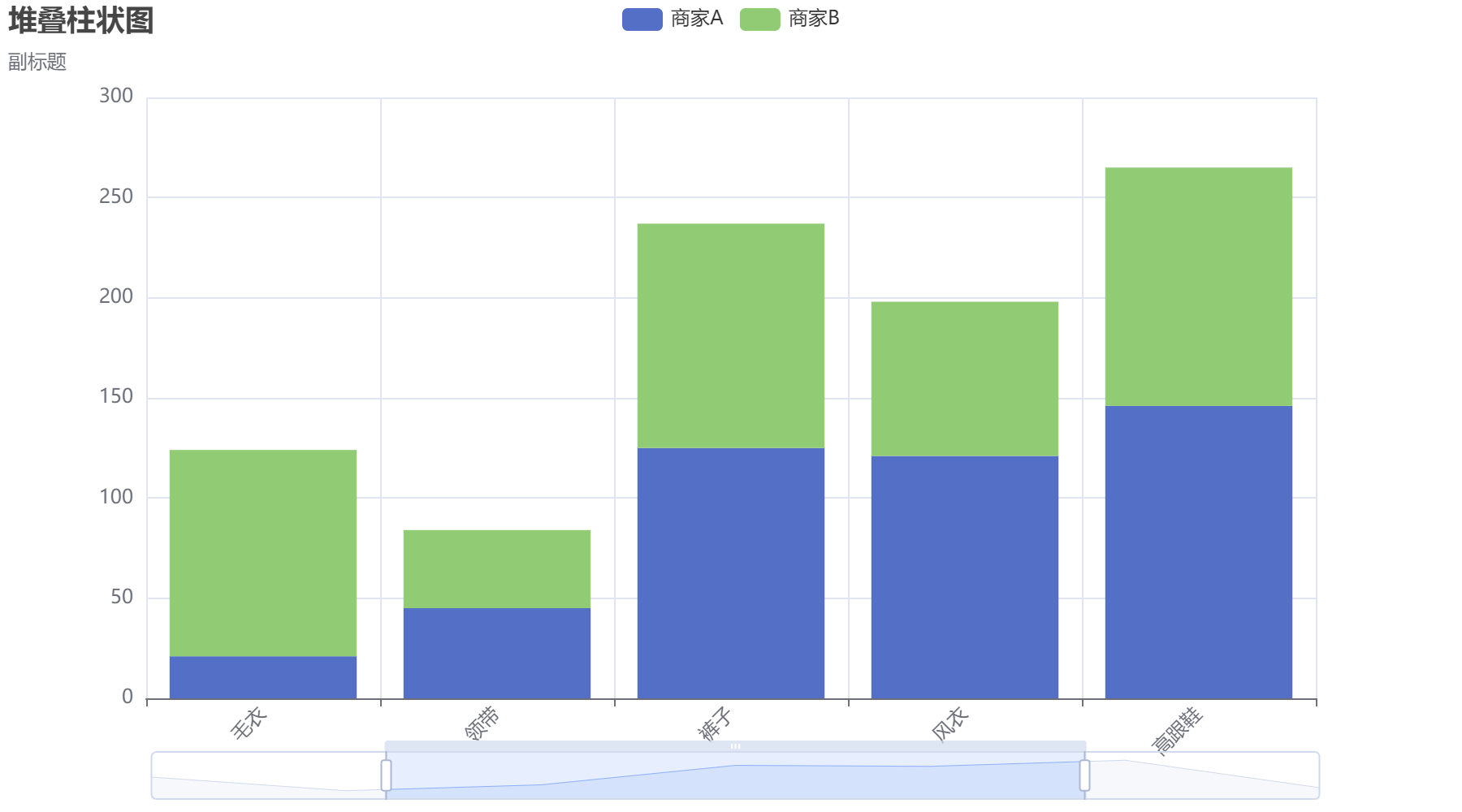
条形图
1
2
3
4
5
6
7
8
9
10
11
12
13
14
15
c=(
Bar()
.add_xaxis(Faker.choose())
.add_yaxis('商家A',Faker.values())
.add_yaxis('商家B',Faker.values())
.reversal_axis() #反转轴
.set_series_opts(
label_opts=opts.LabelOpts(is_show=True,position='right')
)
.set_global_opts(
title_opts=opts.TitleOpts(title='条形图',subtitle='副标题'),
)
)
c.render_notebook()
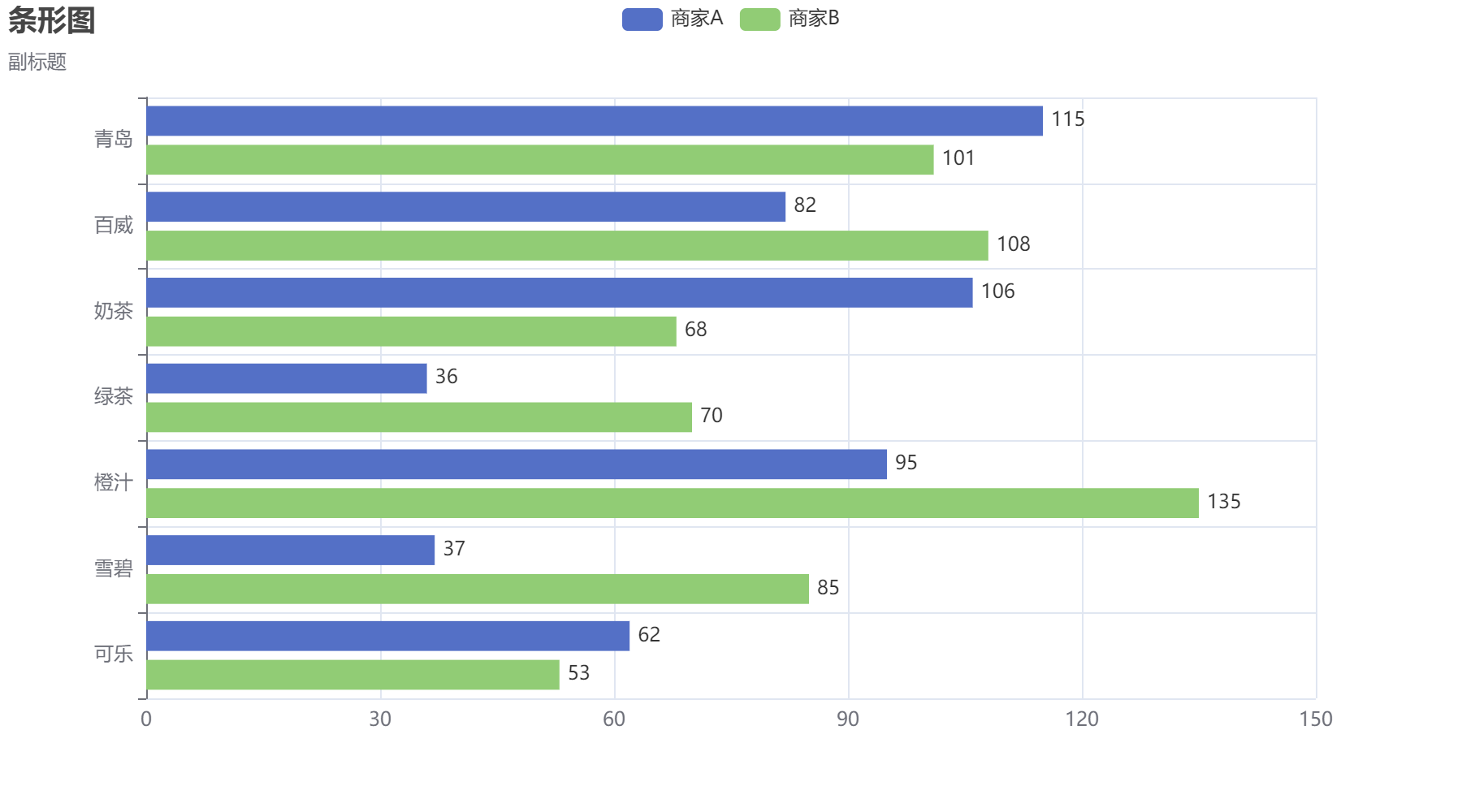
直方图
不同系列柱子之间的距离
1
2
3
4
5
6
7
8
9
10
11
c=(
Bar()
.add_xaxis(Faker.choose())
.add_yaxis('商家A',Faker.values(),gap='0%')
.add_yaxis('商家B',Faker.values(),gap='0%')
.set_global_opts(
title_opts=opts.TitleOpts(title='不同系列柱子之间距离'),
)
)
c.render_notebook()
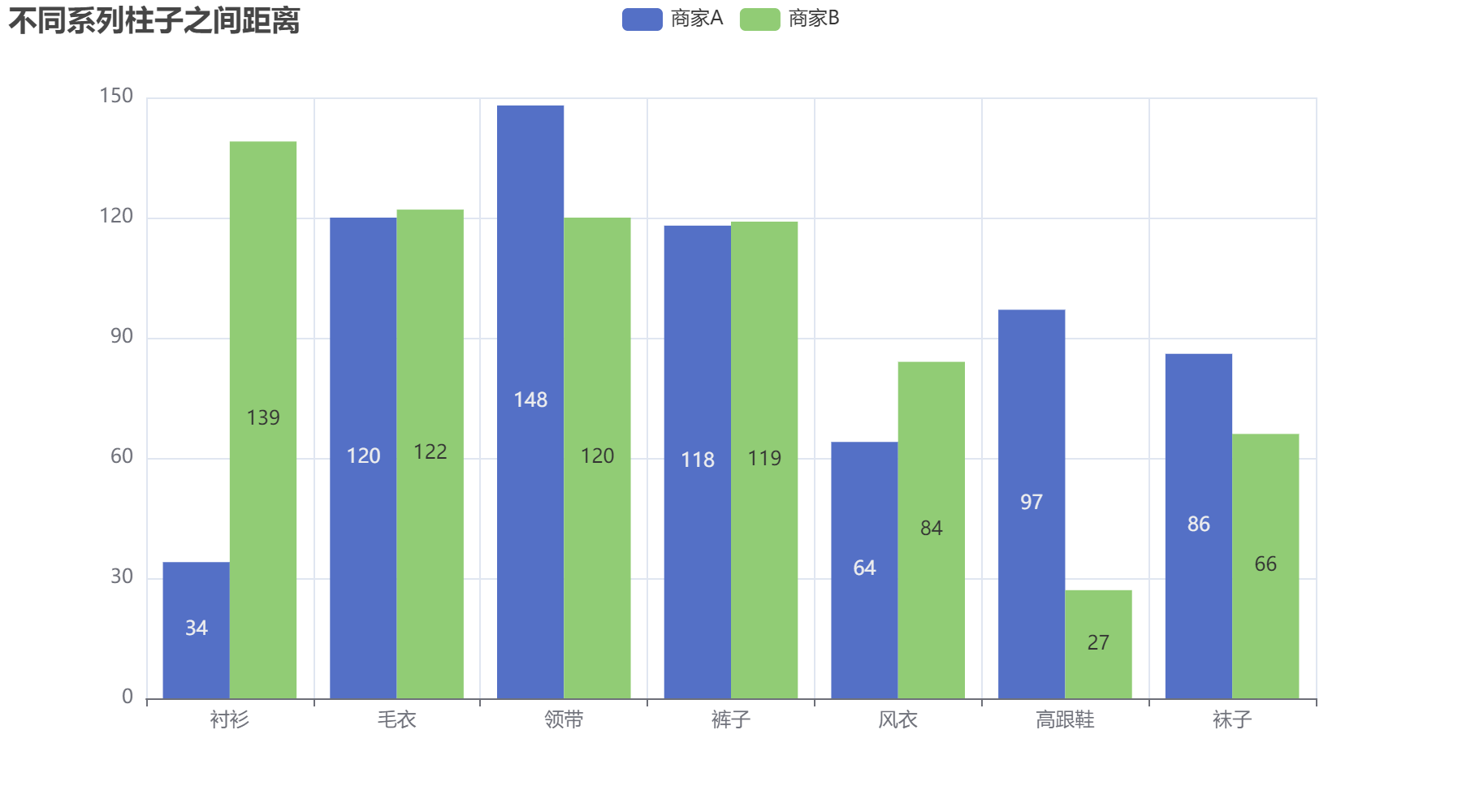
单系列柱子之间的间距
1
2
3
4
5
6
7
8
9
10
c=(
Bar()
.add_xaxis(Faker.choose())
.add_yaxis('商家A',Faker.values(),category_gap='5%')
.set_global_opts(
title_opts=opts.TitleOpts(title='直方图'),
)
)
c.render_notebook()
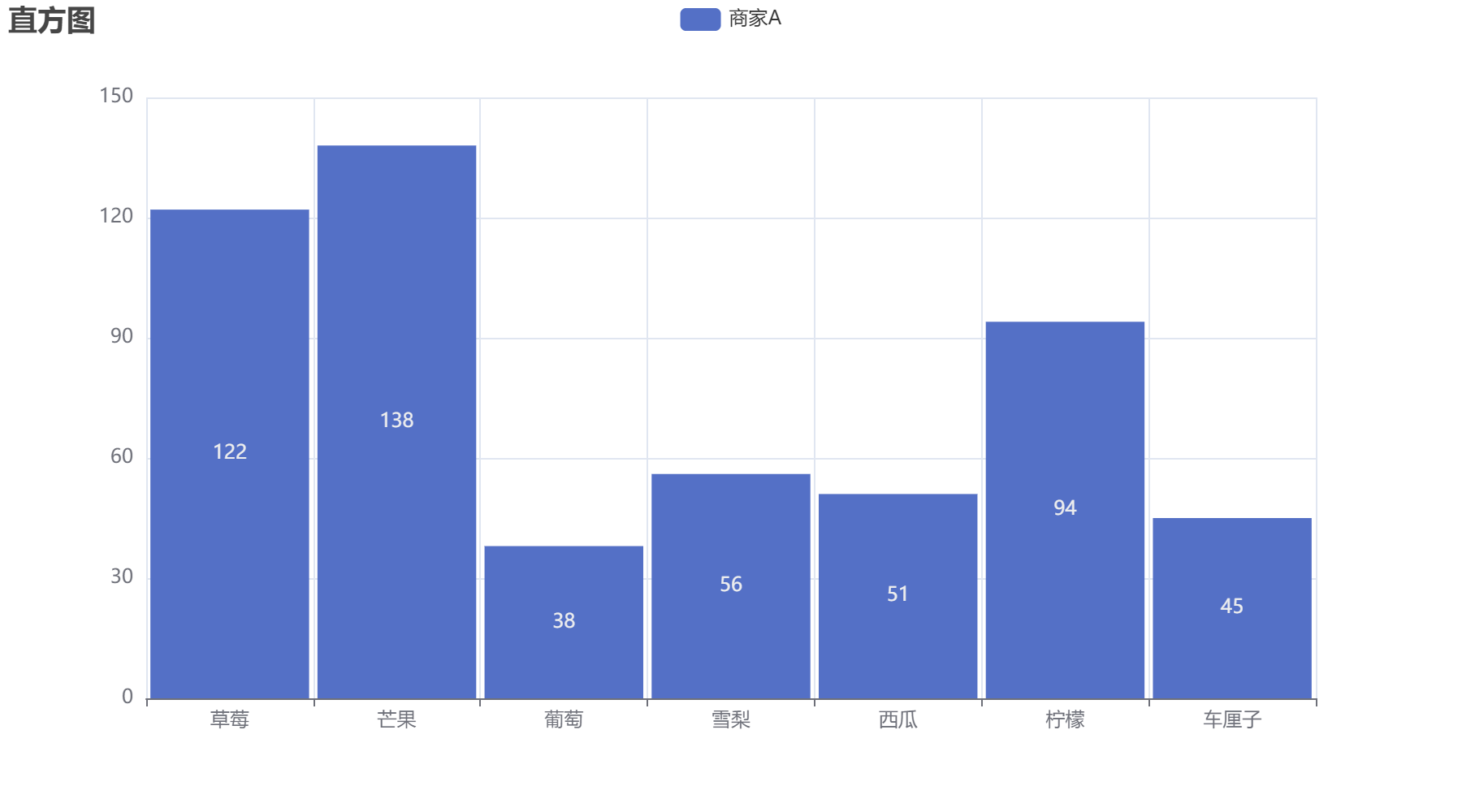
JsCode自定义柱颜色
1
2
3
4
5
6
7
8
9
10
11
12
13
14
15
16
17
18
19
20
21
22
23
24
25
26
27
28
29
30
31
32
33
34
35
36
color_func="""
function (params){
if (params.value > 0 && params.value < 50){
return 'red';
}
else if (params.value > 50 && params.value < 100){
return 'green';
}
return 'blue';
}
"""
c=(
Bar()
.add_xaxis(Faker.choose())
.add_yaxis(
'商家A',Faker.values(),
itemstyle_opts=opts.ItemStyleOpts(color=JsCode(color_func)),
)
.add_yaxis(
'商家B',Faker.values(),
itemstyle_opts=opts.ItemStyleOpts(color=JsCode(color_func)),
)
.add_yaxis(
'商家C',Faker.values(),
itemstyle_opts=opts.ItemStyleOpts(color=JsCode(color_func)),
)
.set_global_opts(
title_opts=opts.TitleOpts(title='直方图'),
)
)
c.render_notebook()
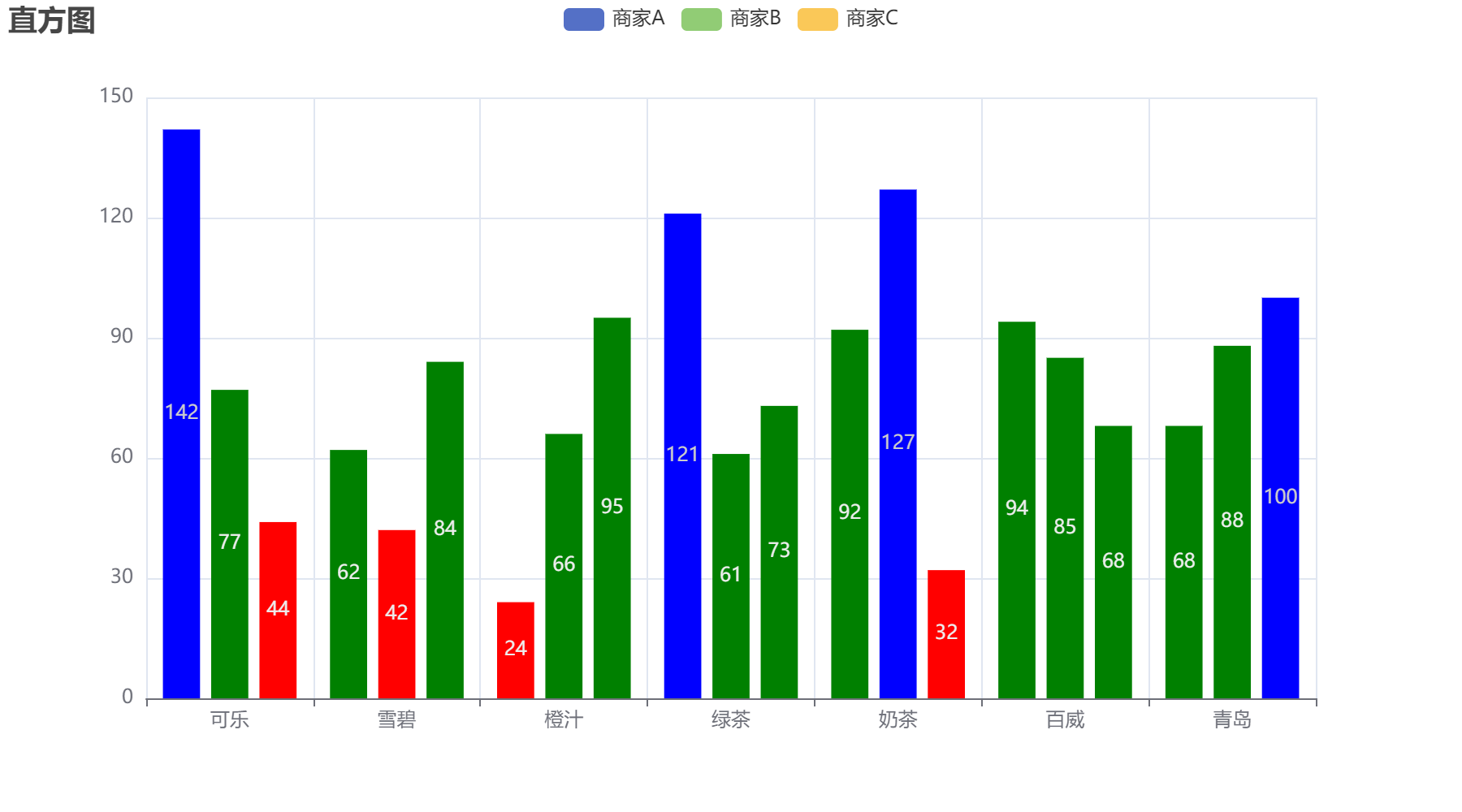
象形柱状图
1
2
from pyecharts.charts import PictorialBar
from pyecharts.globals import SymbolType
1
2
3
4
5
6
7
8
9
10
11
12
13
14
15
16
17
18
19
20
21
22
23
24
25
26
27
28
location = ['山西','四川','西藏','北京','上海','内蒙古','云南','黑龙江','广东','福建']
values = [13,42,67,81,86,94,166,220,249,262]
c = (
PictorialBar()
.add_xaxis(location)
.add_yaxis(
'',
values,
label_opts=opts.LabelOpts(is_show=True),
symbol_repeat='fixed', #重复方式
symbol=SymbolType.ROUND_RECT, #象形符号类型
symbol_size=16, #符号裁剪
is_symbol_clip=True
)
.reversal_axis()
.set_global_opts(
title_opts=opts.TitleOpts(title='象形柱状图'),
xaxis_opts=opts.AxisOpts(is_show=False), #不显示x轴
yaxis_opts=opts.AxisOpts(
axistick_opts=opts.AxisTickOpts(is_show=False), #不显示y轴刻度
axisline_opts=opts.AxisLineOpts(is_show=False)
),
)
.set_series_opts(
label_opts=opts.LabelOpts(position='right')
)
)
c.render_notebook()
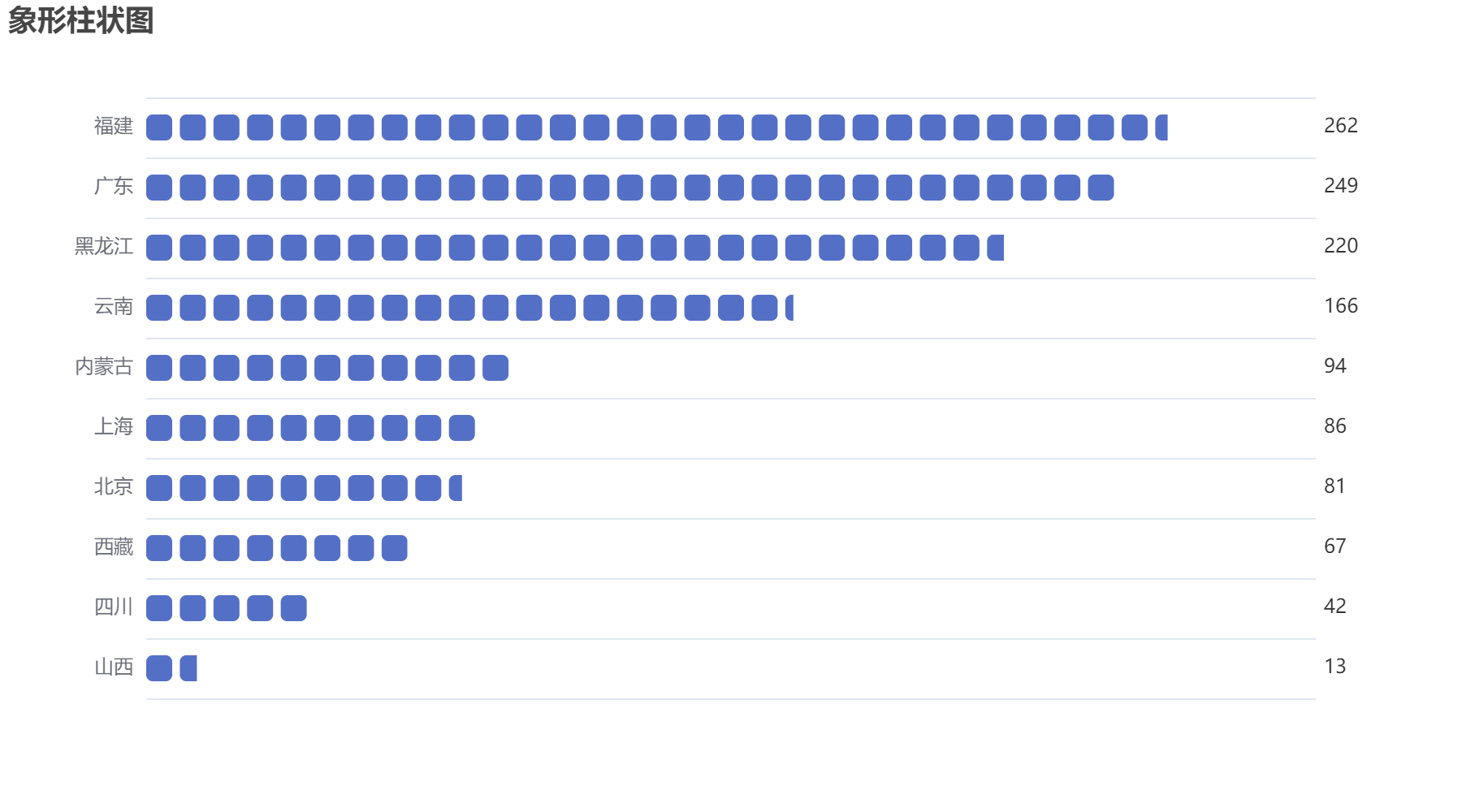
雷达图
1
from pyecharts.charts import Radar
1
2
v1 = [[4300,10000,28000,35000,50000,19000]]
v2 = [[5000,14000,28000,31000,42000,21000]]
1
2
3
4
5
6
7
8
9
10
11
12
13
14
15
16
17
18
19
20
21
c=(
Radar()
.add_schema(
schema=[
opts.RadarIndicatorItem(name='项目1',max_=6000),
opts.RadarIndicatorItem(name='项目2',max_=16000),
opts.RadarIndicatorItem(name='项目3',max_=30000),
opts.RadarIndicatorItem(name='项目4',max_=38000),
opts.RadarIndicatorItem(name='项目5',max_=60000),
opts.RadarIndicatorItem(name='项目6',max_=22000)
]
)
.add('数据1',v1,color='red')
.add('数据2',v2)
.set_series_opts(
label_opts=opts.LabelOpts(is_show=False),
linestyle_opts=opts.LineStyleOpts(width=5)
)
)
c.render_notebook()
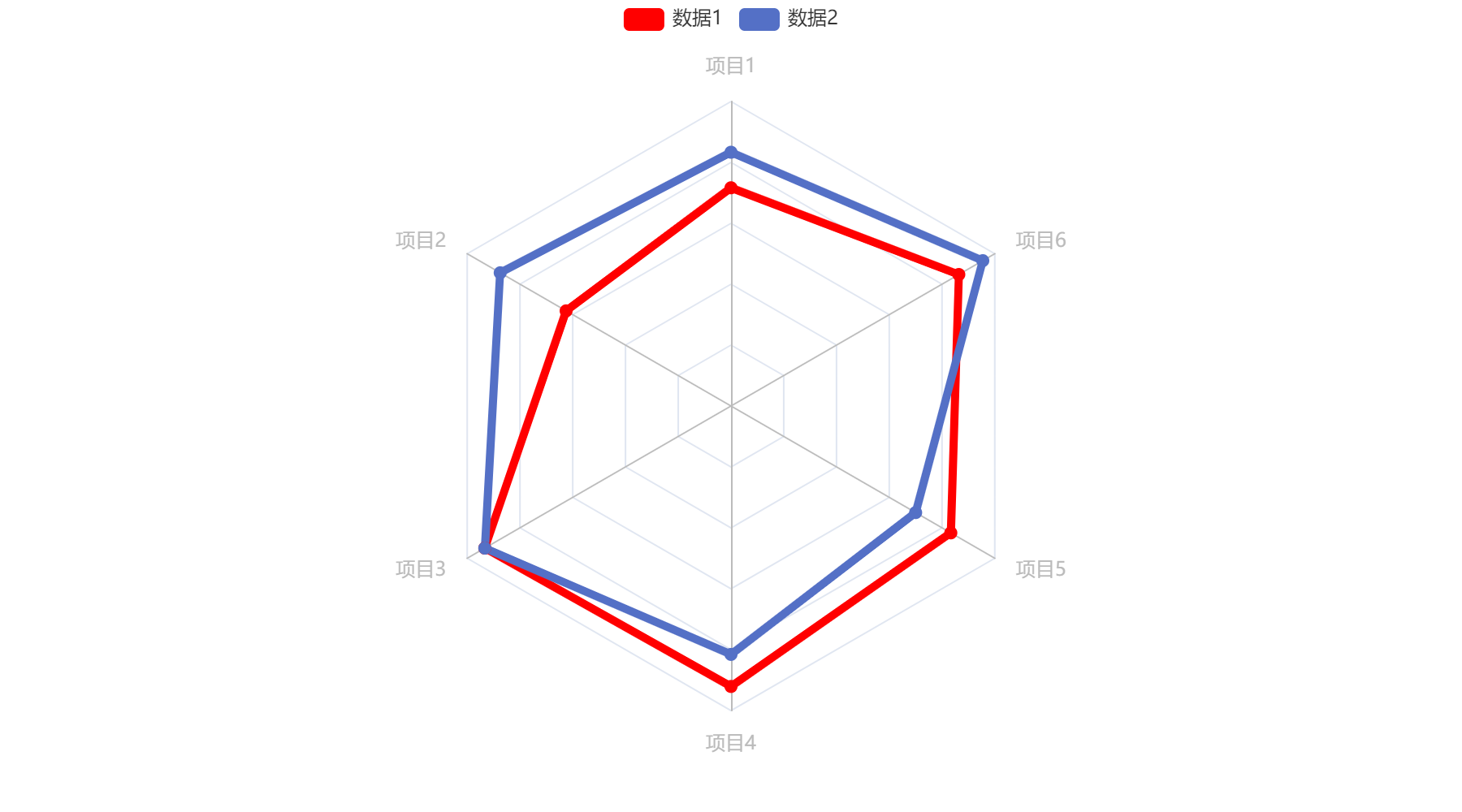
折线图
1
from pyecharts.charts import Line
1
2
3
4
5
6
7
8
9
10
11
12
13
14
15
16
17
18
19
20
21
22
23
24
25
c=(
Line()
.add_xaxis(Faker.choose())
.add_yaxis('商家A',Faker.values())
.add_yaxis('商家B',Faker.values(),is_smooth=True) #平滑曲线
.set_global_opts(
title_opts=opts.TitleOpts(
title='折线图'
),
tooltip_opts=opts.TooltipOpts(
trigger='axis'
),
yaxis_opts=opts.AxisOpts(
splitline_opts=opts.SplitLineOpts(is_show=False),
is_show=True,
axisline_opts=opts.AxisLineOpts(
is_show=True
)
),
xaxis_opts=opts.AxisOpts(
splitline_opts=opts.SplitLineOpts(is_show=False)
),
)
)
c.render_notebook()

1
2
3
4
5
6
7
8
9
10
11
12
13
14
15
16
17
18
19
20
21
22
23
24
25
26
27
28
29
30
31
32
33
34
35
36
37
38
39
40
41
42
43
c=(
Line(init_opts=opts.InitOpts(width='1000px',height='500px'))
.add_xaxis(xaxis_data=Faker.week)
.add_yaxis(
series_name='',
y_axis=[120,200,150,80,70,110,130],
symbol='triangle', #点类型
symbol_size=20,
#线条样式
linestyle_opts=opts.LineStyleOpts(
color='green',
width=2,
type_='dashed',
),
label_opts=opts.LabelOpts(is_show=False),
itemstyle_opts=opts.ItemStyleOpts(
border_width=2,border_color='red',color='blue'
),
markpoint_opts=opts.MarkPointOpts(
data=[
opts.MarkPointItem(type_='max'),
opts.MarkPointItem(type_='min')
]
),
markline_opts=opts.MarkLineOpts(
data=[
opts.MarkLineItem(type_='average')
],
)
)
.set_global_opts(
yaxis_opts=opts.AxisOpts(
type_='value',
splitline_opts=opts.SplitLineOpts(
is_show=True
)
),
tooltip_opts=opts.TooltipOpts(trigger='axis')
)
)
c.render_notebook()
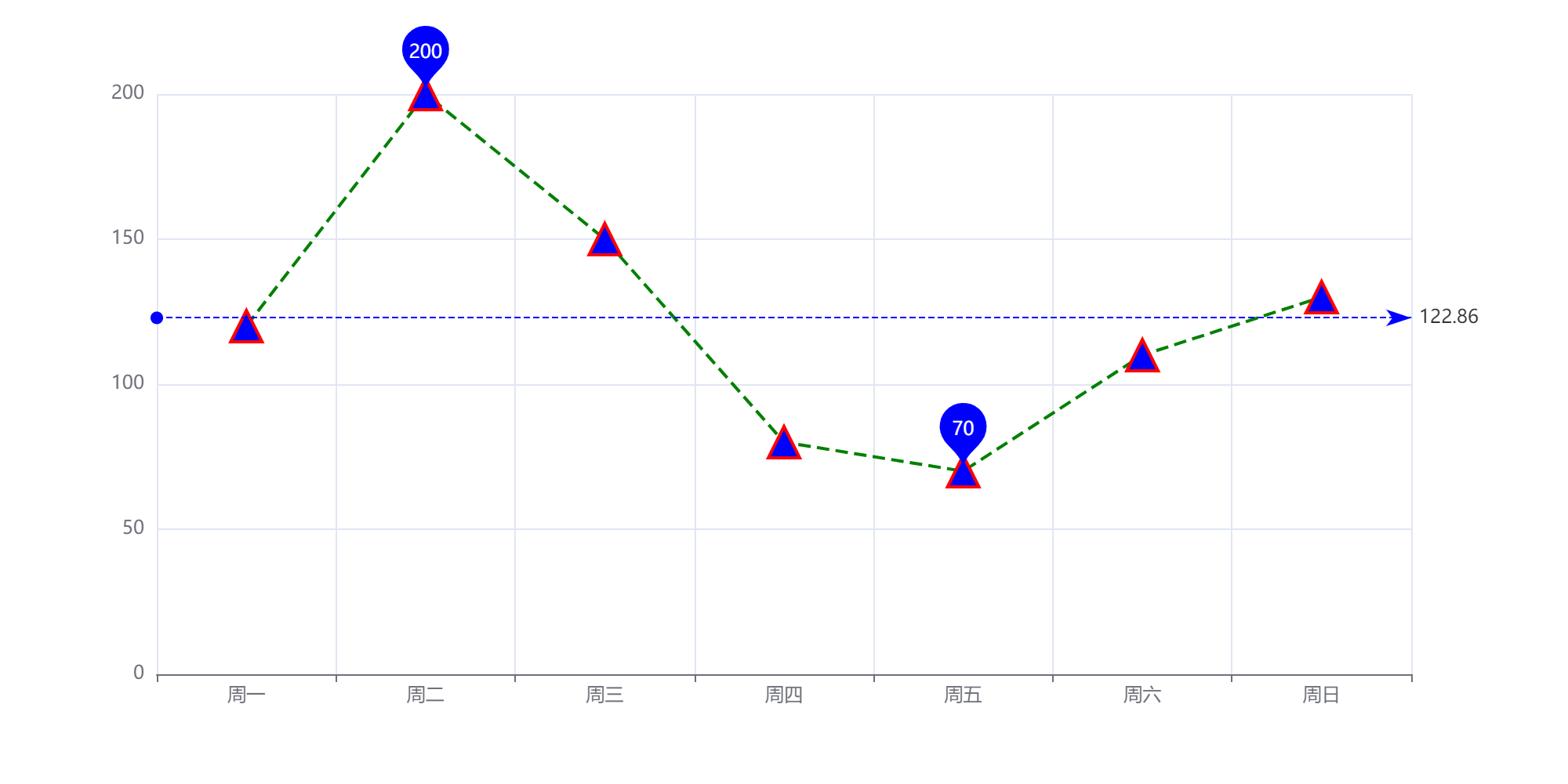
面积图
1
2
3
4
5
6
7
8
9
10
11
12
13
14
15
16
c=(
Line()
.add_xaxis(Faker.week)
.add_yaxis(
'',
y_axis=[120,130,100,140,90,200,150],
areastyle_opts=opts.AreaStyleOpts(opacity=0.5)
)
.set_global_opts(
title_opts=opts.TitleOpts(title='面积图'),
tooltip_opts=opts.TooltipOpts(trigger='axis'),
xaxis_opts=opts.AxisOpts(type_='category',boundary_gap=False)
)
)
c.render_notebook()
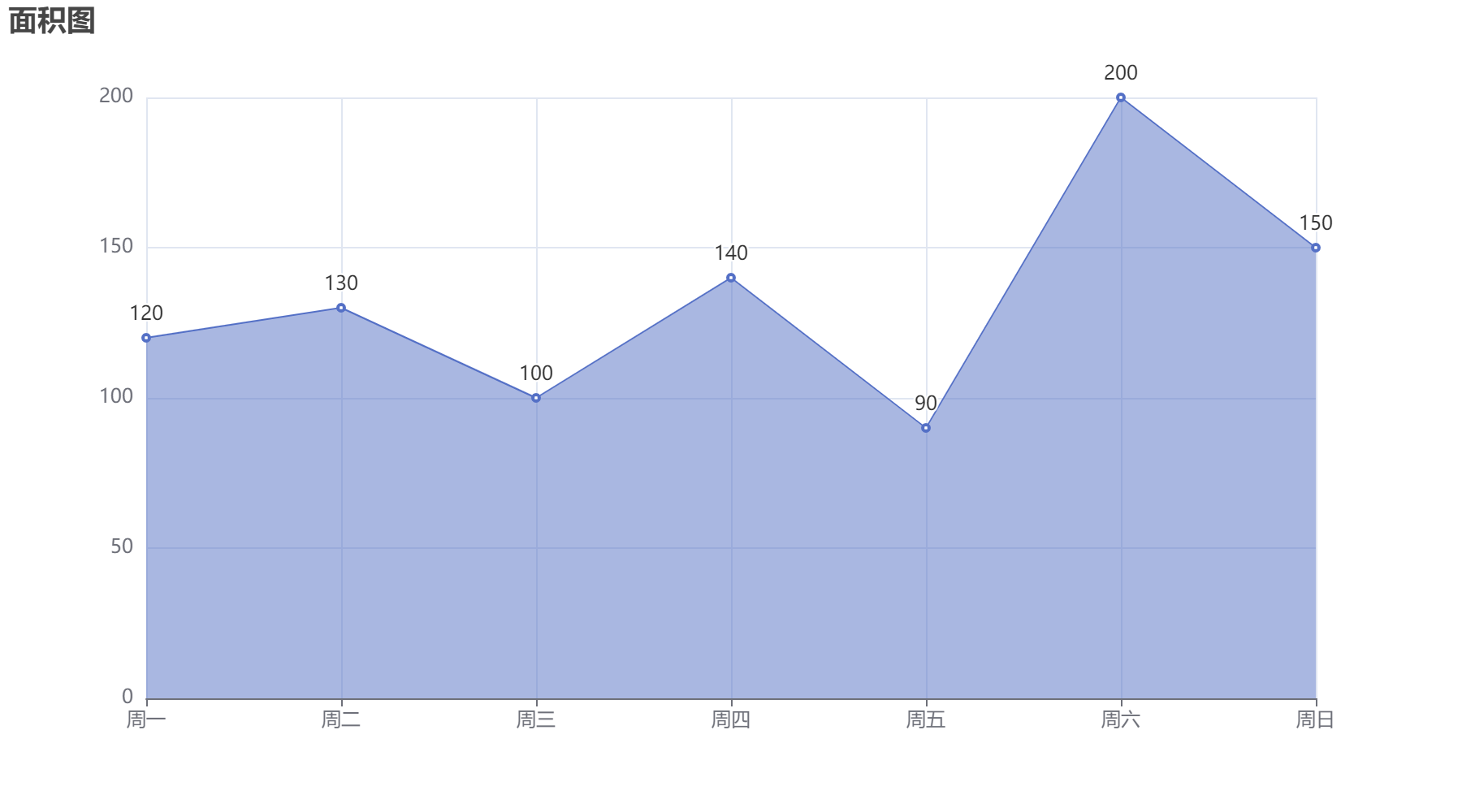
堆叠面积图
1
2
3
4
5
6
7
8
9
10
11
12
13
14
15
16
17
18
19
20
21
22
23
24
25
26
27
28
29
30
31
32
33
34
35
36
37
c=(
Line()
.add_xaxis(Faker.week,)
.add_yaxis(
'广告',
stack='堆叠',
y_axis=[120,40,100,30,50,60,150],
areastyle_opts=opts.AreaStyleOpts(opacity=0.5),
label_opts=opts.LabelOpts(is_show=False)
)
.add_yaxis(
'销售',
stack='堆叠',
y_axis=[120,40,100,30,50,60,150],
areastyle_opts=opts.AreaStyleOpts(opacity=0.5),
label_opts=opts.LabelOpts(is_show=False)
)
.add_yaxis(
'流量',
stack='堆叠',
y_axis=[120,40,100,30,50,60,150],
areastyle_opts=opts.AreaStyleOpts(opacity=0.5),
label_opts=opts.LabelOpts(is_show=False)
)
.add_yaxis(
'浏览',
stack='堆叠',
y_axis=[120,40,100,30,50,60,150],
areastyle_opts=opts.AreaStyleOpts(opacity=0.5),
label_opts=opts.LabelOpts(is_show=False)
)
.set_global_opts(
title_opts=opts.TitleOpts(title='堆叠面积图'),
xaxis_opts=opts.AxisOpts(type_='category',boundary_gap=False)
)
)
c.render_notebook()
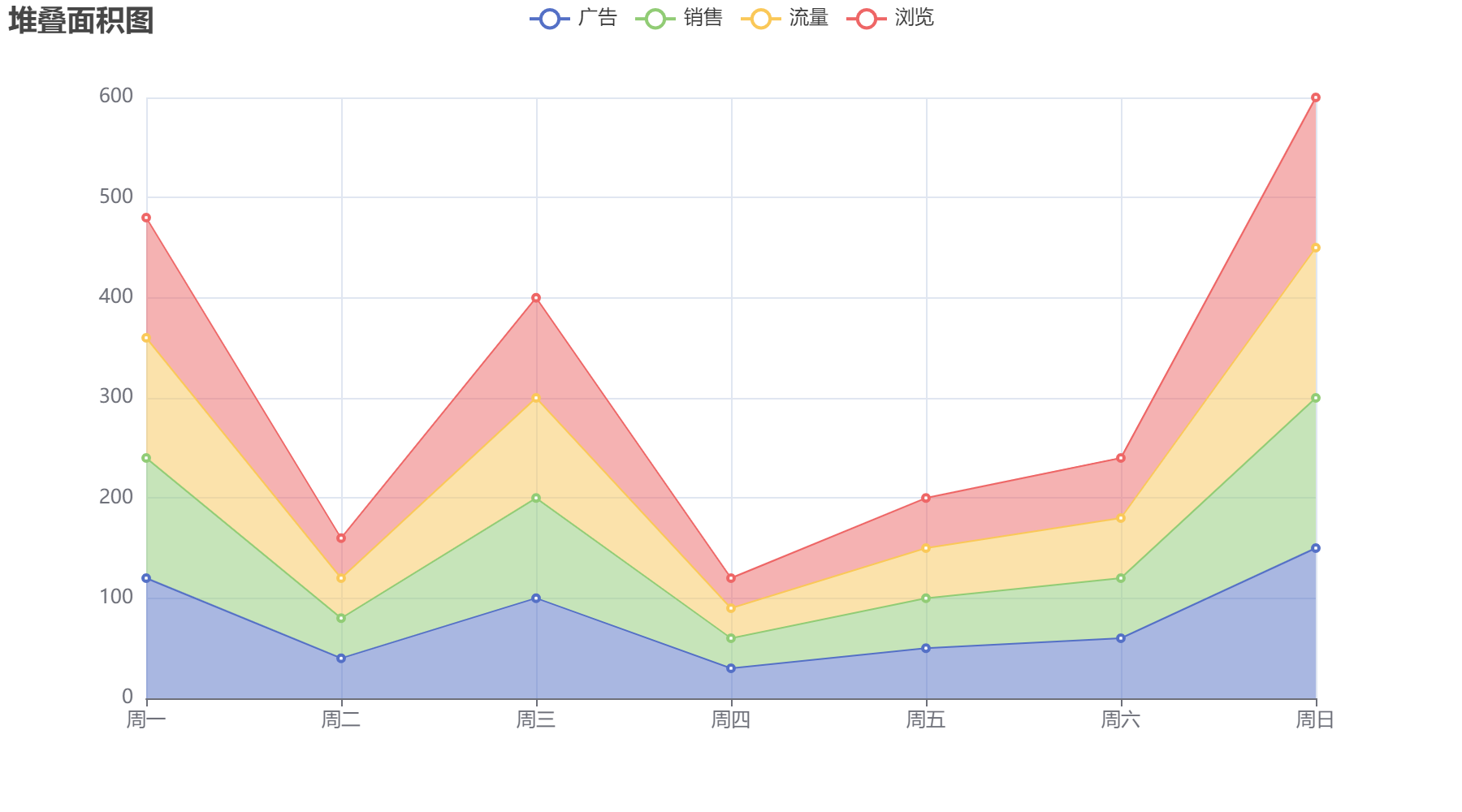
散点图
1
from pyecharts.charts import Scatter
1
2
3
4
5
6
7
8
9
10
11
12
13
data=[
[10.0,8.04],
[8.0,6.95],
[13.0,7.58],
[9.0,8.81],
[11.0,8.33],
[14.0,9.96],
[6.0,7.24],
[4.0,4.26],
[12.0,10.84],
[7.0,4.82],
[5.0,5.68]
]
1
data.sort(key=lambda x: x[0])
1
2
3
x_data = [d[0] for d in data]
y_data = [d[1] for d in data]
display(x_data,y_data)
1
2
3
4
5
[4.0, 5.0, 6.0, 7.0, 8.0, 9.0, 10.0, 11.0, 12.0, 13.0, 14.0]
[4.26, 5.68, 7.24, 4.82, 6.95, 8.81, 8.04, 8.33, 10.84, 7.58, 9.96]
1
2
3
4
5
6
7
8
9
10
11
12
13
14
15
16
17
18
19
20
c=(
Scatter(
init_opts=opts.InitOpts(width='800px',height='400px')
)
.add_xaxis(xaxis_data=x_data)
.add_yaxis(
'',
y_axis=y_data,
symbol_size=20,
label_opts=opts.LabelOpts(is_show=True,position='top')
)
.set_global_opts(
xaxis_opts=opts.AxisOpts(
min_=2,
type_='value',
)
)
)
c.render_notebook()
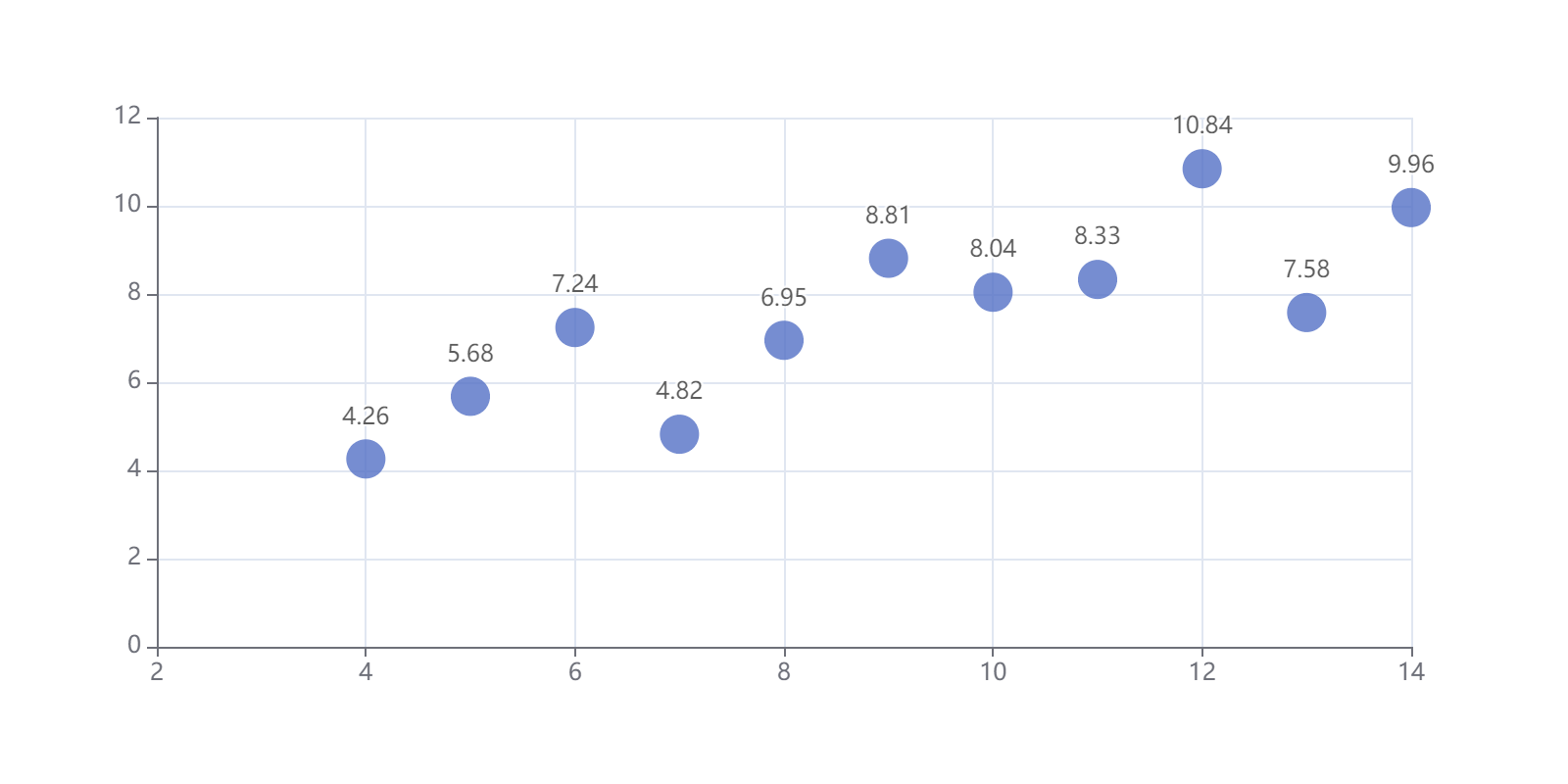
涟漪散点图
1
2
from pyecharts.charts import EffectScatter
from pyecharts.globals import SymbolType
1
2
3
4
5
6
7
8
9
10
11
12
13
14
15
16
c=(
EffectScatter()
.add_xaxis(Faker.choose())
.add_yaxis(
'',
Faker.values(),
symbol=SymbolType.ARROW,
symbol_size=25,
color='red',
label_opts=opts.LabelOpts(position='top')
)
.set_global_opts(
title_opts=opts.TitleOpts(title='涟漪散点图'),
)
)
c.render_notebook()
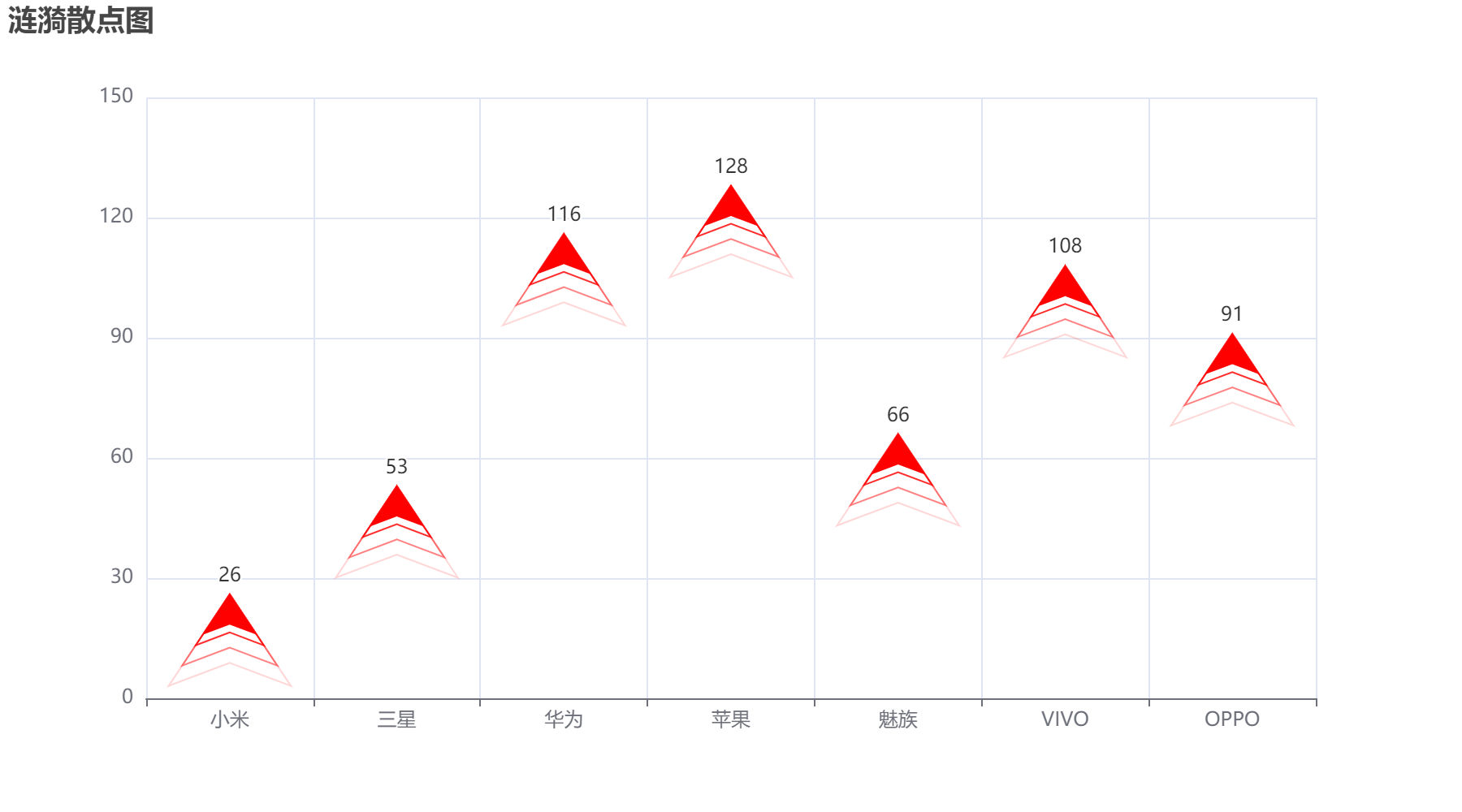
热力图
1
2
from pyecharts.charts import HeatMap
import random
1
value = [[i,j,random.randint(0,100)] for i in range(24) for j in range(7)]
1
2
3
4
5
6
7
8
9
10
11
c=(
HeatMap()
.add_xaxis(Faker.clock)
.add_yaxis(
'',
Faker.week,
value,
label_opts=opts.LabelOpts(color='auto'),
)
)
c.render_notebook()
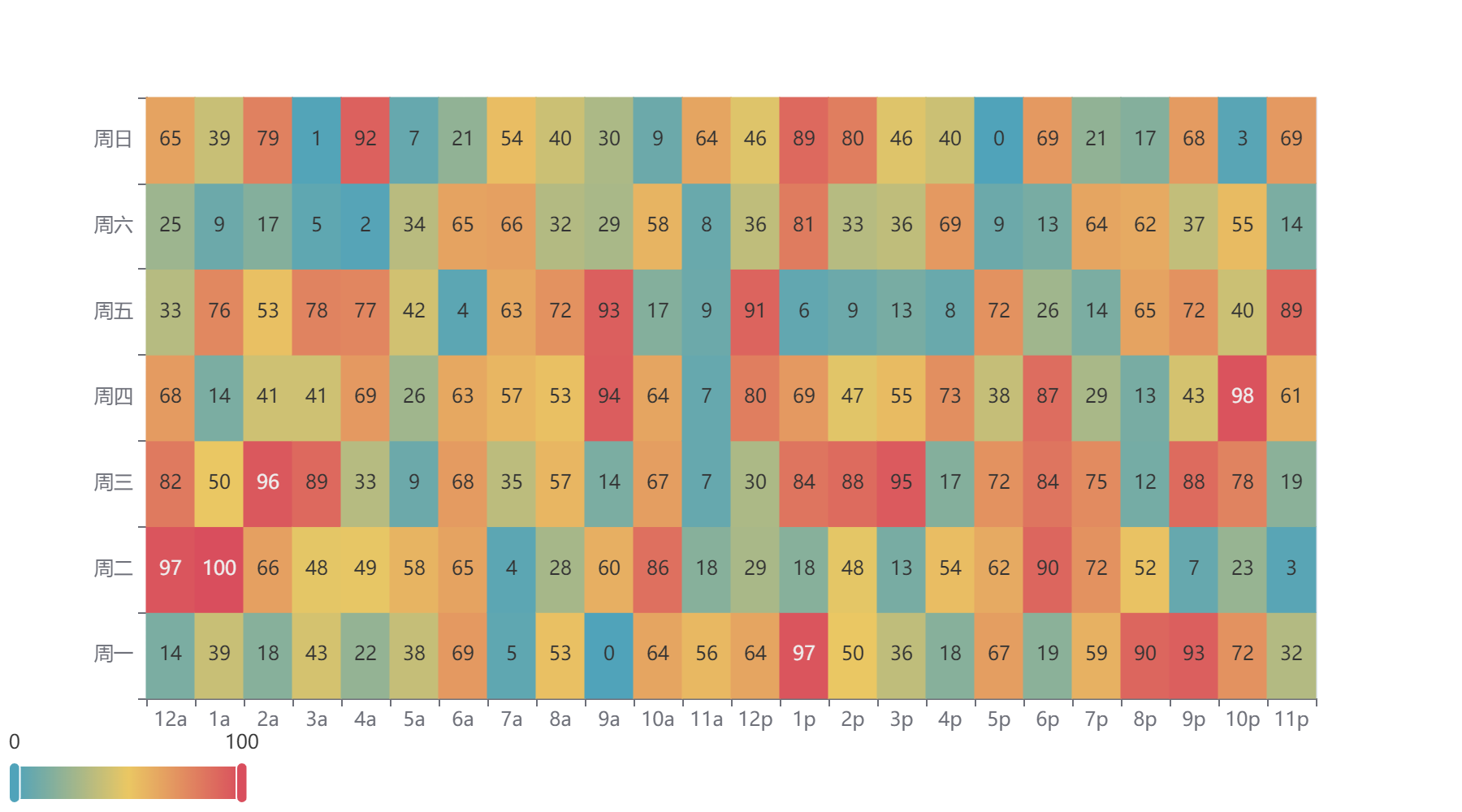
日历图
1
2
from pyecharts.charts import Calendar
import datetime
1
2
begin = datetime.date(2023,1,1)
end = datetime.date(2024,1,1)
1
(end-begin).days
1
365
1
2
data = [[str(begin+datetime.timedelta(days=i)),random.randint(1000,25000)]
for i in range((end-begin).days)]
1
data[0],data[-1]
1
(['2023-01-01', 4652], ['2023-12-31', 15378])
1
2
3
4
5
6
7
8
9
10
11
12
13
14
15
16
17
18
19
20
21
22
23
24
25
c = (
Calendar(
init_opts=opts.InitOpts(height='220px')
)
.add(
'',
data,
calendar_opts=opts.CalendarOpts(
range_='2023',
daylabel_opts=opts.CalendarDayLabelOpts(name_map='cn'),
monthlabel_opts=opts.CalendarMonthLabelOpts(name_map="cn")
)
)
.set_global_opts(
visualmap_opts=opts.VisualMapOpts(
max_=25000,
min_=1000,
orient="horizontal",
is_piecewise=True,
pos_top="230px",
pos_left="100px",
)
)
)
c.render_notebook()

1
from pyecharts.charts import Boxplot
1
2
3
4
5
6
7
8
v1 = [
[850,740,900,1070,930,850,950,980,980,880,1000,980],
[960,940,960,940,880,800,850,880,900,840,830,790],
]
v2 = [
[890,810,810,820,800,770,760,740,750,760,910,920],
[890,840,780,810,760,810,790,810,820,850,870,870],
]
箱型图
1
2
3
4
5
c=Boxplot()
c.add_xaxis(['demo1','demo2'])
c.add_yaxis('A',c.prepare_data(v1))
c.add_yaxis('B',c.prepare_data(v2))
c.render_notebook()
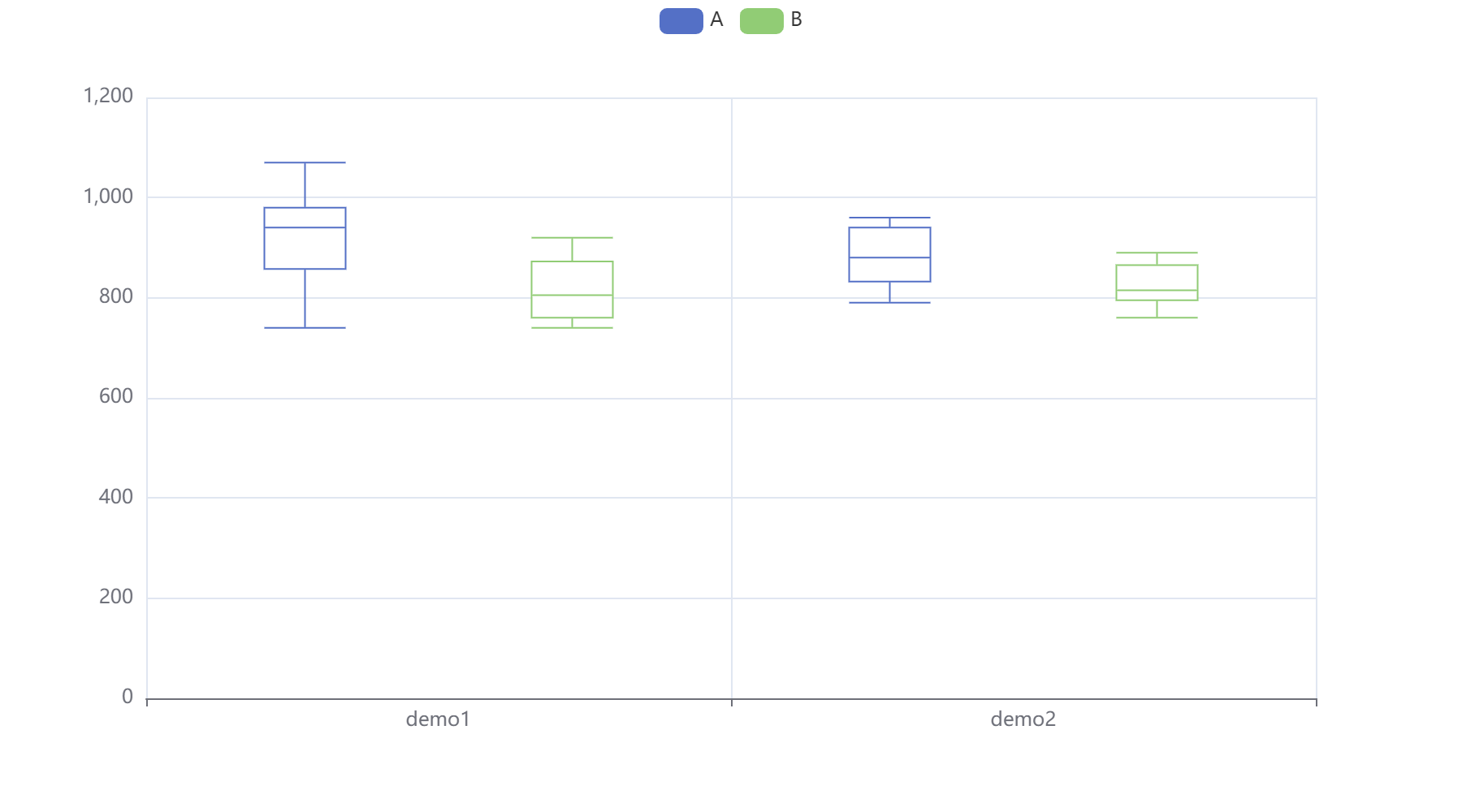
词云图
1
from pyecharts.charts import WordCloud
1
2
3
4
5
6
# wordcloud = (
# WordCloud()
# .add("", data_pair = words, word_size_range=[6,60],textstyle_opts=opts.TextStyleOpts(font_family='Microsoft YaHei',font_weight='bold'))
# .set_global_opts(title_opts=opts.TitleOpts(title="《政府工作报告(2021)》新词",title_textstyle_opts = opts.TextStyleOpts(font_size = 25,color="midnightblue")))
# )
# wordcloud.render_notebook()
漏斗图
1
from pyecharts.charts import Funnel
1
[list(i) for i in zip(Faker.choose(),Faker.values())]
1
2
3
4
5
6
7
[['小米', 22],
['三星', 81],
['华为', 54],
['苹果', 46],
['魅族', 55],
['VIVO', 124],
['OPPO', 40]]
1
2
3
4
5
6
7
8
c=(
Funnel()
.add('商品',[list(i) for i in zip(Faker.choose(),Faker.values())])
.set_global_opts(
title_opts=opts.TitleOpts(title='漏斗图')
)
)
c.render_notebook()
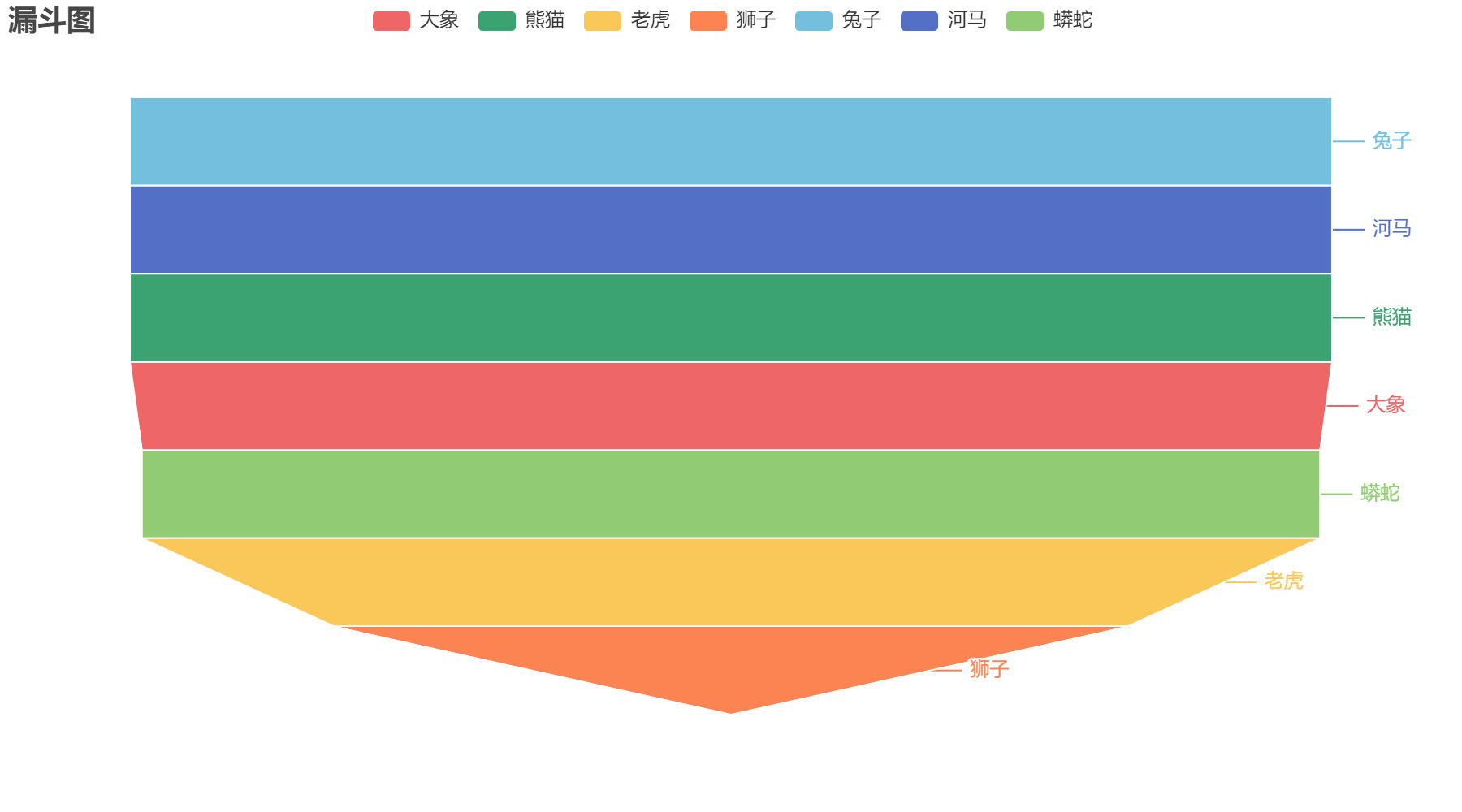
1
2
3
4
x_data=['访问','点击','咨询','加购','下单']
y_data=[100,80,60,40,20]
data=[[x_data[i],y_data[i]] for i in range(len(x_data))]
1
2
3
4
5
6
7
8
9
10
11
12
13
14
15
16
17
18
19
20
21
22
23
c=(
Funnel(
init_opts=opts.InitOpts(width='600px',height='400px')
)
.add(
'漏斗图',
data_pair=data,
gap=5,
tooltip_opts=opts.TooltipOpts(
trigger='item',
formatter='{a}<br/> {b}:{c}'
),
label_opts=opts.LabelOpts(
is_show=True,
position='inside',
font_size=16
)
)
.set_global_opts(
title_opts=opts.TitleOpts(title='漏斗图')
)
)
c.render_notebook()
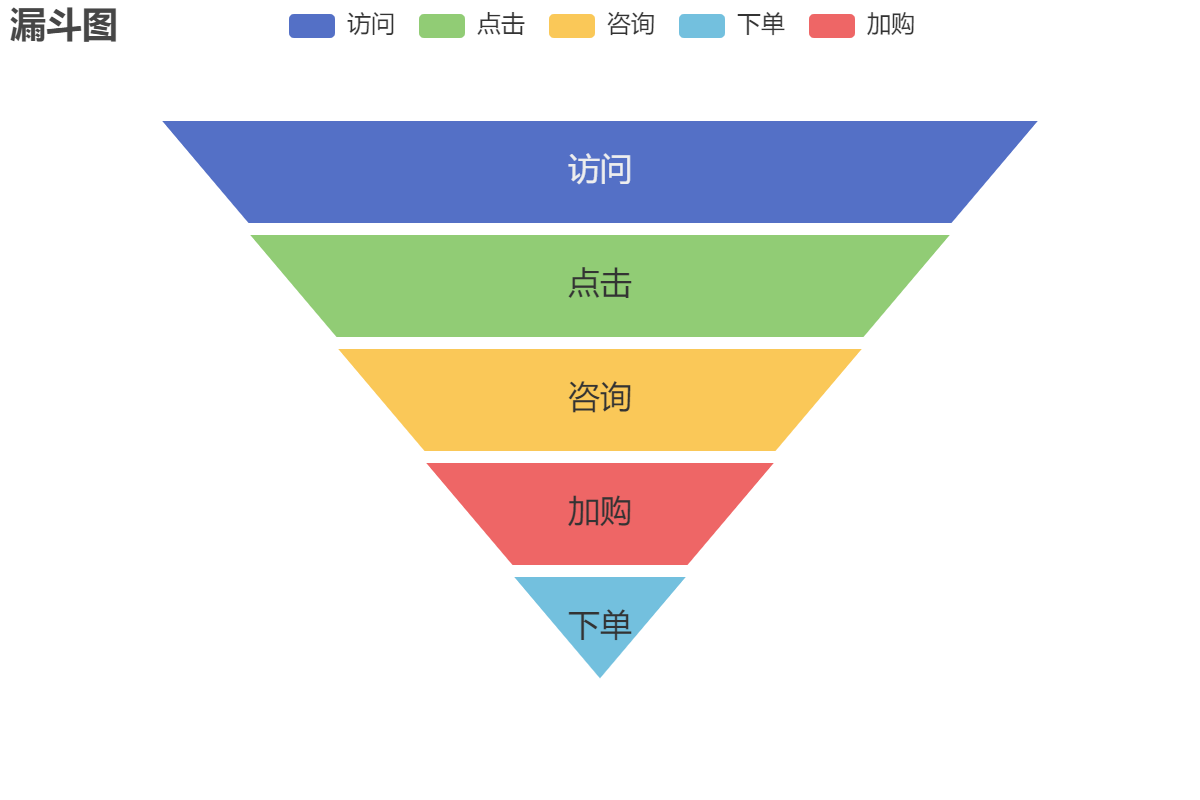
极坐标图
1
from pyecharts.charts import Polar
1
data=[(i,random.randint(1,100)) for i in range(100)]
1
2
3
4
5
6
7
8
9
10
11
12
13
14
15
16
17
18
19
20
21
c=(
Polar()
.add(
'极坐标',
data,
type_='scatter',
label_opts=opts.LabelOpts(
is_show=False,
),
symbol_size=10
# effect_opts=opts.EffectOpts(
# scale=10
# )
)
.set_global_opts(
title_opts=opts.TitleOpts(
title='极坐标图'
)
)
)
c.render_notebook()
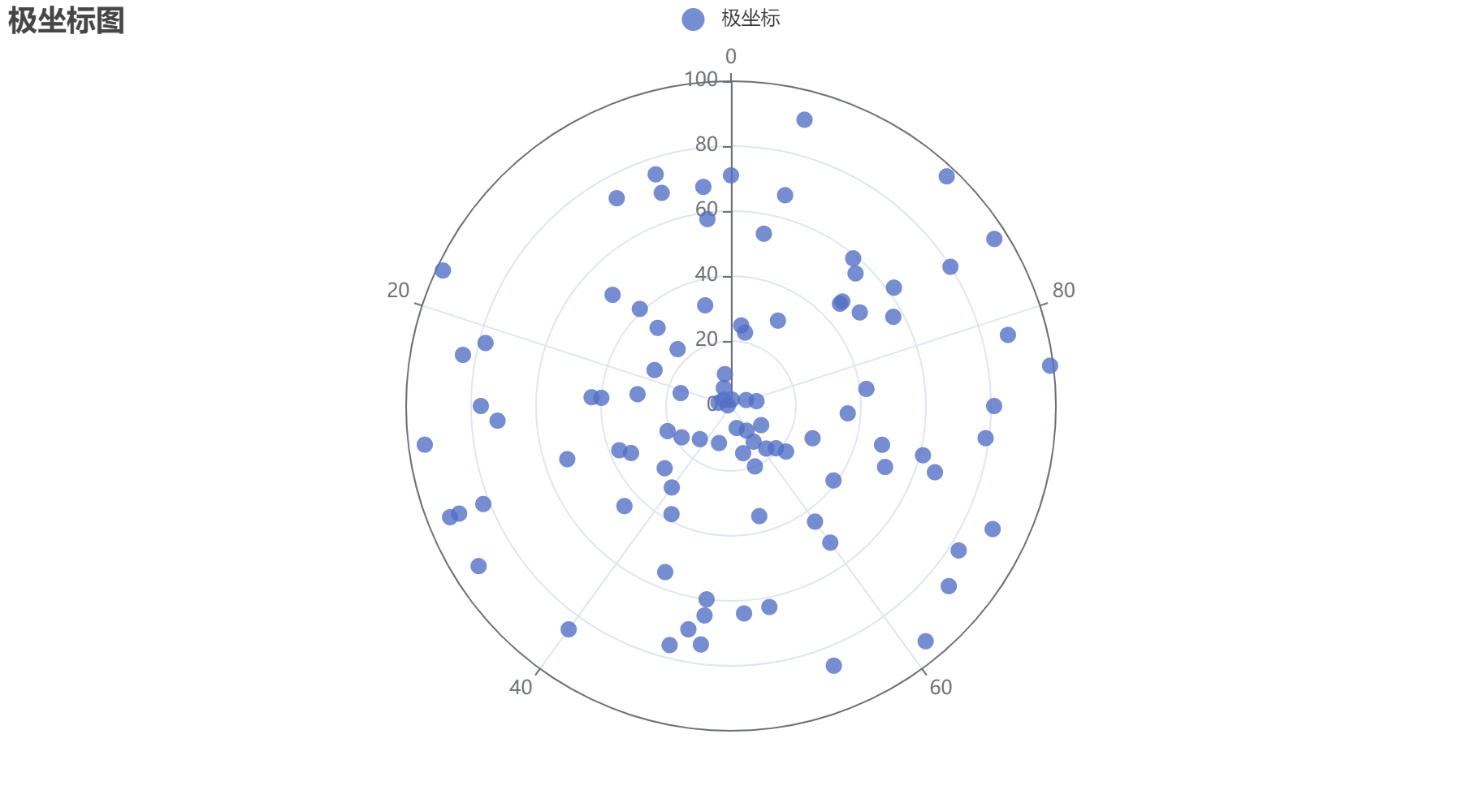
1
2
3
4
5
6
7
8
9
10
11
12
13
14
15
c=(
Polar()
.add_schema(
radiusaxis_opts=opts.RadiusAxisOpts(
data=Faker.week,
type_='category'
),
angleaxis_opts=opts.AngleAxisOpts(
is_clockwise=True,
max_=10
)
)
.add('商品',[1,2,3,4,3,5,1],type_='bar')
)
c.render_notebook()
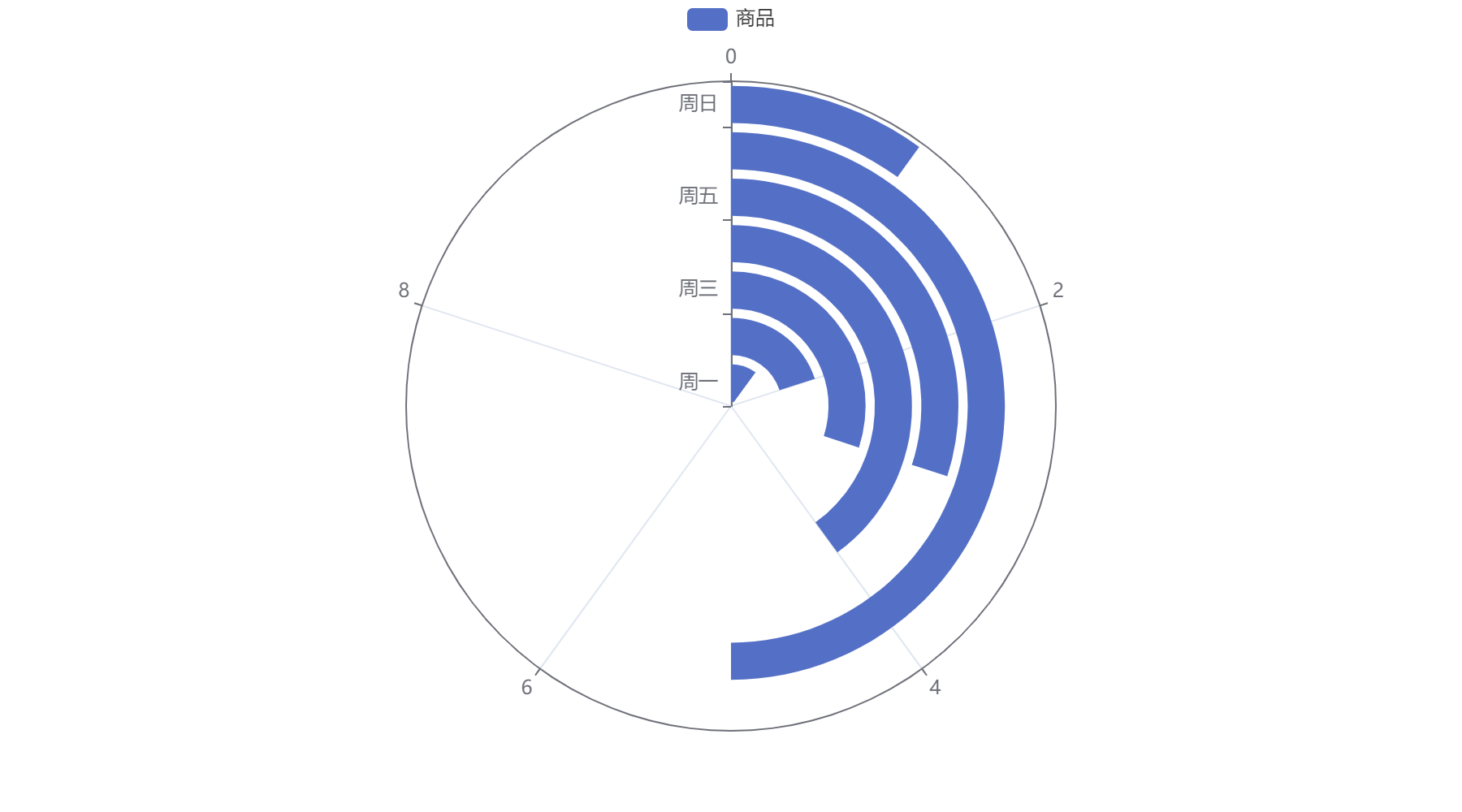
1
2
3
4
5
6
7
8
9
10
11
12
13
14
15
16
17
18
19
20
21
22
c=(
Polar()
.add_schema(
# radiusaxis_opts=opts.RadiusAxisOpts(
# data=Faker.week,
# type_='category'
# ),
angleaxis_opts=opts.AngleAxisOpts(
data=Faker.week,
type_='category'
)
)
.add('商品A',[1,2,3,4,3,5,1],type_='bar',stack='abc')
.add('商品B',[2,4,3,5,2,3,1],type_='bar',stack='abc')
.add('商品C',[1,2,3,4,3,5,1],type_='bar',stack='abc')
.set_global_opts(
title_opts=opts.TitleOpts(
title='极坐标图+堆叠柱形图'
)
)
)
c.render_notebook()
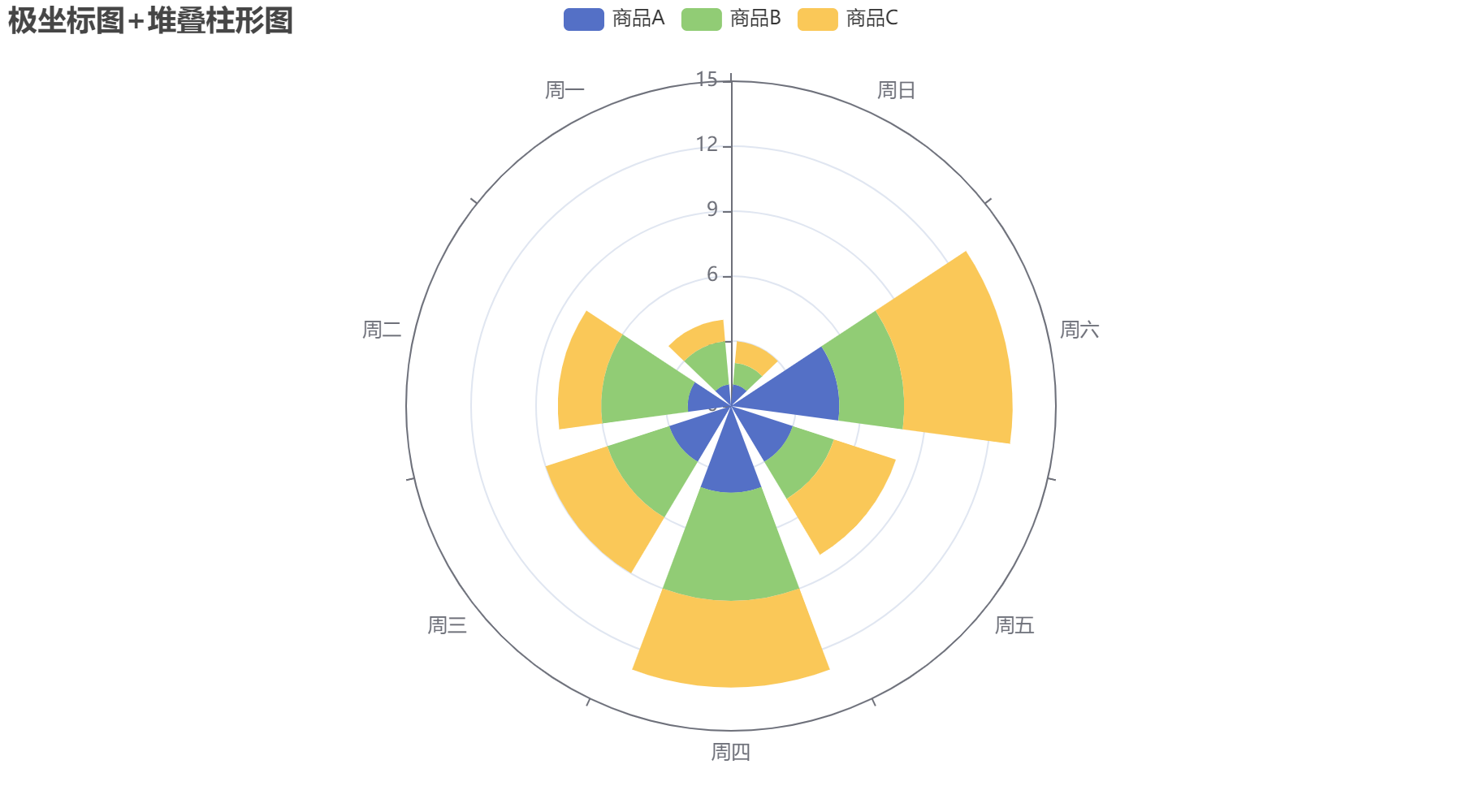
水球图
1
from pyecharts.charts import Liquid
1
2
3
4
5
6
# c =(
# Liquid()
# .add('',[0.2,0.7]) #0.7水百分之七十,0.2显示数值
# .set_global_opts(title_opts=opts.TitleOpts(title='水球图'))
# )
# c.render_notebook()
桑基图
1
from pyecharts.charts import Sankey
1
2
3
4
5
6
7
8
9
10
11
12
13
14
15
16
17
nodes = [
{'name':'c1'},
{'name':'c2'},
{'name':'c3'},
{'name':'c4'},
{'name':'c5'},
{'name':'c6'},
{'name':'c7'}
]
links=[
{'source':'c1','target':'c2','value':10},
{'source':'c2','target':'c3','value':20},
{'source':'c3','target':'c4','value':30},
{'source':'c5','target':'c6','value':50},
{'source':'c6','target':'c7','value':60},
]
1
2
3
4
5
6
7
8
9
10
11
12
13
14
15
16
c=(
Sankey()
.add(
'',
nodes, #所有节点
links, #节点之间的链接关系
linestyle_opt=opts.LineStyleOpts(
opacity=0.2, #透明度
curve=0.6, #曲线幅度
color='red'
),
# label_opts=opts.LabelOpts(position='right')
)
.set_global_opts(title_opts=opts.TitleOpts(title='桑基图'))
)
c.render_notebook()
